


























































Ella Paulin Managing Editor
Following a five-week pause on room bookings for speaker events, McGill has released an updated procedure for event bookings on campus. The room booking pause was enacted after a talk featuring Mosan Hassan Yousef was moved online in response to a death threat—which came as part of backlash against the talk due to the speaker’s prior Islamophobic comments on social media. The procedure, which went into effect on Jan. 1, involves a new form for room booking requests and codifies the security measures McGill may implement in response to concerns about safety at an event.
The guidelines centralize the room-booking process, using a single form to book any McGill-administered space. The new process also requires a room booking request to be submitted 10 days in advance, rather than the previous five-day window. The guidelines do not explicitly state that McGill may modify or cancel an event on the basis of its content or the speaker’s past statements, although they do note that “Requestors are responsible for ensuring that their events’ proceedings, speakers, etc., remain in accordance with applicable laws and university policies.”
Students’ Society of McGill University (SSMU) Vice-President (VP) University Affairs Abe Berglas commented on the policy’s lack of
language outlining a path to cancel an event based on the past statements of invited speakers or the content of the event in an interview with The Tribune
“I think maybe [the policy] is trying to depoliticize the issue, and that’s why it’s framed in terms of security alone and not reasons why people may be protesting a speech,” Berglas said. “I’m […] waiting to see what McGill does in its actions, like what events it tries to cancel or make more difficult to happen, and then what events it facilitates.”
Additionally, the revised room booking procedure states that, in response to security concerns, McGill reserves the right to require organizers to implement ticketing, limit attendance to McGill community members, or relocate to a different room. Should these adjustments fail to resolve the security concerns, McGill also reserves the right to move an event online.
Although she has not yet had any experience with McGill implementing security measures through this policy, Arts Undergraduate Society VP Internal Sophie Nguyen has used the new booking form and told The Tribune that it has been an improvement so far.
“It has been smooth sailing this semester,” Nguyen wrote in an email. “There have been a couple of kinks that needed tinkering but otherwise the system seems to be faster and more efficient.”
Despite this, several members of the McGill University Senate have raised criticisms about McGill’s communications around their pause on room bookings this November. In a written statement to The Tribune, the McGill Media Relations Office (MRO) stated that the decision to pause new room bookings was taken seriously and announced in response to the severity of the security concerns, which included reports of a death threat, surrounding the talk featuring Yousef.

“In the interests of security and stability, notably for students heading into the examination period, a pause was announced [...] for five weeks, more than three of which fell in the examination and winter holiday period,” the MRO wrote. “We saw this as the only viable option in the circumstances.”
SSMU Arts Senator Vivian Wright submitted a question at the Jan. 15 McGill Senate meeting alleging that many students interpreted the phrasing of McGill’s initial email announcing the pause in room bookings as including events like
final exam review sessions and end-of-semester parties. The university did not clarify until several days later that it was only intended to apply to speaker events. SSMU Arts Senator Anzhu Wei spoke with The Tribune about this confusion.
“Amongst the student senators and the Senate caucus, we had heard a lot of complaints from different student departments about how this really had a very big negative impact for a lot of their events,” Wei said. “It sounded like this really was a breakdown of communication where the administration either didn’t fully think through the full impact of their decision, or that they just didn’t communicate it effectively.”
Olivia Ardito Staff Writer
The Students’ Society of McGill University (SSMU) recently shifted the duties of Vice-President (VP) Student Life to a different position: Director of Clubs and Services. Hamza Abu Alkhair, the recently appointed Director, is a U2 Electrical Engineering student. He started as the Director on Nov. 15 and completed onboarding for his new responsibilities on Jan. 19. He is currently the SSMU Services Representative and is also an active member of the SSMU Legislative Council, through which he has experience working in the VP Student Life portfolio.
The VP Student Life position has remained vacant following Chloé Muñoz’s resignation from the role on Oct. 29. SSMU held a by-election to fill the role in late November, but the results were nullified as the election failed to meet quorum. SSMU did not hold an election to appoint Abu Alkhair to the position of Director of Clubs and Services. He will remain responsible for the VP Student Life duties until a newly elected VP takes over on May 31.
SSMU President Dymetri Taylor told The Tribune that the student union made this change to the Director of Clubs and Services position because there are currently two executive vacancies and the VP Student Life position entails an extensive work-

load. Instead of having the other SSMU executives continue to assume the role’s responsibilities, SSMU distributed them to Abu Alkhair. In addition, Abu Alkhair will sit on the SSMU executive board, but will not receive a vote.
“It was akin to the responsibilities of a Fire Chief being given to the Deputy Fire Chief,” wrote Taylor.
Taylor added that this redelegation of responsibilities will allow the rest of the SSMU executives to focus their complete attention on the core requirements of their
own roles, rather than having to juggle extra tasks. Additionally, Taylor explained that the creation of the Director role will give clubs and services the attention and focus they deserve.
Abu Alkhair told The Tribune that he was selected for the transfer of responsibilities because he was already taking on some of the VP Student Life responsibilities, and that he can now help lighten the workload for all SSMU executives since he will oversee club applications and manage services they were previously responsible for due to
the vacancy.
“As the previous president of [Arab Student Network] ASN I found that we had a lot of challenges that SSMU could help out with especially when it came to managing funds, room bookings, and Activities Night,” Abu Alkhair wrote. “My goal is to be more involved with clubs and help as much as I can. We are in this together.”
Abu Alkhair’s plans for his new responsibilities include reevaluating SSMU’s clubs and services review process to improve efficiency, increasing acceptance speed for new club applications, and adding more resources for clubs on the SSMU website.
Former VP Student Life candidate Alice Postovskiy wrote to The Tribune that she was disheartened by this development, given her campaign for VP Student Life in November and prior experience as a club and service executive.
“Students should demand change!” Postovskiy wrote. “We deserve a student union accountable to its members. We deserve a SSMU without nullified elections, unclear rules, and an unelected Board.” Postovskiy also noted that SSMU has not set a similar precedent in past by-elections that also failed to meet quorum.
“I would have hoped that the SSMU consulted with its student groups [....] As always, the lack of communication is uninspiring,” Postovskiy wrote.
Russel Ismael Contributor
On Nov. 27, the Association of Graduate Students Employed at McGill (AGSEM) elected a bargaining committee to negotiate on behalf of Unit 3, representing over 250 members. Unit 3 is composed of “course-based academic casuals,” which include graders, course assistants, and graduate teaching fellows. Unit 3 is separate from AGSEM’s Units 1 and 2, which represent teaching assistants (TAs) and invigilators, respectively.
Despite Unit 3’s fairly recent formation, they have already elected bargaining com-
mittees to negotiate working conditions. AGSEM’s priorities for Unit 3 include pay equity with TAs, protections against harassment and discrimination, and clearer workload definitions. All members are also able to voice their own experiences during negotiations as part of Unit 3’s open bargaining agreement.
Donnie Morard, a PhD candidate in History and Classical Studies and member of the Unit 3 Bargaining Committee, elaborated on the negotiation process in an interview with The Tribune
“Unit 1 TAs went into bargaining last year, so we pushed really hard to make sure these other groups of workers would be protected under a union,” Morard said. “One of the key issues is McGill creates these positions of graders who oftentimes have very similar jobs or tasks as TAs.”

Morard explained that this lack of distinction between a TA’s and a grader’s duties can create inequities. Although some TAs may head tutorials, run office hours, and offici-
ate labs, the responsibilities of many TAs can also be limited to only grading assignments— much like Unit 3 workers.
“Some TA-ships are simply just grading. It’s the exact same job, [a grader] is just as qualified, but it’s more than a $10 [CAD] difference [in pay], along with less protections in terms of hiring and workloads,” Morard said. “We want to close that gap.”
Megan Millet, U3 Arts and a member of the Unit 3 Bargaining Support Committee, noted that this disparity between jobs falling under Unit 3 and those under other Unit divisions varies by department and faculty, making it difficult to ensure consistent protection for AGSEM members.
“What we’ve noticed in Unit 3 is that [McGill] has like 50 different titles for job postings to make sure it is difficult to make sure who falls under Unit 3,” Millet said in an interview with The Tribune. “We’re trying to consolidate this to make sure everyone can be represented, and so that McGill can’t just create new positions whenever they want.”
While McGill is aware of Unit 3’s demands, they have not yet met with AGSEM to discuss them. However, Morard argues that McGill can negotiate the non-monetary aspects as soon as possible.
“There’s a lot of non-monetary aspects to our collective agreement as well, such as hiring practices or topics dealing with harassment and discrimination.” Morard stated. “One of the things we’ve proposed is to hold off on
the monetary demands, and we can essentially submit on the non-monetary proposal and start working on this to get the ball rolling.”
However, seeing as the semester has only just begun, Morard expressed some understanding for McGill’s slow deliberation process. In the meantime, AGSEM continues to assess their priorities for future negotiations.
“As of now, we are gathering data by calling up students and Unit 3 members from other departments and faculties for their experience,” Millet explained. “We’re always looking for more people to help join us to make sure we can represent everyone properly.”
In an email to The Tribune, the McGill Media Relations Office (MRO) declined to share the details of their negotiations with AGSEM.
“McGill works with well over a dozen unions, doing our utmost to undertake all negotiations in a timely manner,” the MRO wrote. “That said, we do not comment publicly on details of talks with them.”
Despite these delays, Morard remains optimistic about the future of labour relations at McGill.
“[Unions] create solidarity among different groups of workers on campus and, even though I think the administration doesn’t necessarily like this change, we see McGill union culture becoming stronger,” Morard stated. “I think [unionizing] is not something we can do at the bargaining table, but instead something that we could just do.”
The Canada Award lessens financial burden for some out-of-province
Asher Kui Staff Writer
In October 2023, the Quebec provincial government announced its plan to increase tuition at English universities for out-of-province Canadian students.
While the government’s original plans were to nearly double tuition rates, in December 2023, Higher Education Minister Pascale Déry settled on hiking tuition rates by about 30 per cent. In an effort to sustain out-of-province undergraduate applications, McGill launched the Canada Award, while Concordia University launched the Canada Scholars Award—both of which subsidize part of the increased tuition for most out-ofprovince students.
According to McGill’s Fall 2024 Admissions Profile, 22 per cent of the university’s incoming undergraduate class is from Canada beyond Quebec. For these out-of-province students, The Tribune unpacks the Canada Award.
What is the total monetary value of the Canada Award?
The Canada Award is valued at $3,000 CAD annually, with $1,500 CAD disbursed to recipients each semester. The Award offers up to $12,000 CAD over the course of eight semesters, translating to four years of full-time study.
The award is classified as taxable income, which means recipients must report the return on their T4A tax slips. McGill issues these students a T4A tax slip each February for the award granted in the prior year term.
Why did McGill launch the Canada Award?
In a 2023 CBC interview with journalist
Mark Kelley, McGill Vice-President (Administration and Finance) Fabrice Labeau mentioned that the Quebec government’s intention to raise tuition rates would “price [McGill] out of the market and close access to [...] degrees and to the McGill experience.” The Canada Award was thus created to maintain the university’s competitiveness.
“So what we’re trying to do here is [to send] a message to our students and our prospective students [...] saying, you’re welcome here at McGill,” Labeau said to CBC. “We’re going to help you overcome these new barriers that have been put up by the government.”
In another statement, McGill President and Vice-Chancellor Deep Saini said that the university’s success is founded in the talent of a diverse student body, and the Canada Award aims to support students who otherwise would not be able to come to McGill.
Who is eligible for the Canada Award?
Currently, the Canada Award is offered to out-of-province, full-time undergraduate students admitted to McGill in Fall 2024 or Winter 2025, in the Faculties or Schools of Agricultural and Environmental Science, Architecture, Arts, Arts & Science, Education, Music, Nursing, and Science.
Additionally, students who have undergone an interfaculty transfer in Fall 2024 or Winter 2025 from an ineligible faculty to an eligible faculty can also receive the Canada Award.
To qualify for full-time status, students must be registered and billed for 12 or more credits per semester. If students receiving the award withdraw from a course with a refund and fall under 12 credits, the award will be revoked. Howev-

On top of a 30 per cent tuition increase, starting in Fall 2025, 80 per cent of out-of-province undergraduate students must achieve French proficiency by the time they graduate. (Mia Helfrich / The Tribune)
er, if students withdraw from a course after the refund deadline, they can keep the award.
Students in part-time studies due to a disability can also claim the Canada Award, so long as their disability is recognized by Student Accessibility and Achievement.
For students entering McGill in the Fall 2025 and Winter 2026 semesters, the Canada Award will still be offered, albeit with added restrictions: Canada Award recipients will also have to be in receipt of a one-time or renewable Entrance Scholarship or Bursary.
Students who deferred their admission to the Fall 2025 semester or beyond will only receive the Canada Award if they meet the Fall 2025 eligibility criteria.
How is the Canada Award issued? Does it interact with other scholarships or bursaries?
The Canada Award requires no application. It is automatically deducted from tuition rates on e-Bills for eligible students. During the add-drop period, if a student fluctuates between full-time and part-time status, the Award will simultaneously be added and dropped on their student fees account menu.
McGill scholarships and bursaries are distributed regardless of whether a student is a recipient of the Canada Award.
For more information on the Canada Award, visit McGill’s Scholarships and Student Aid website.
Amelia H. Clark Staff Writer
Kaitlyn Schramm
News Editor
Shani Laskin
Managing Editor
The McGill Senate, Post-Graduate Students’ Society (PGSS) Council, and Legislative Council of the Students’ Society of McGill University (SSMU) each held their first meetings of the semester during the week of Jan. 13-17. Senators explored the potential impacts of Bill 74 and Bill 83, and concerns regarding McGill’s new policy for booking rooms on campus. Meanwhile, PGSS councillors discussed the union’s new online health provider and a letter from the Graduate Law Students’ Association (GLSA) condemning McGill’s ban of event bookings on campus in December. Finally, the Legislative Council’s agenda included the low voter turnout of a recent SSMU by-election and proposed changes to SSMU’s internal regulations.
McGill Senate Jan. 15 meeting
The meeting commenced with messages from the Chair and McGill President, Vice-Chancellor Deep Saini. He expressed worry about Quebec’s passing of Bill 74, which gives the government the ability to cap the amount of international students in universities. Saini noted that the passage of this bill “poses risks to Quebec’s future, threatens the ability to attract top international talent, and could harm Quebec’s innovation and research centers.”
Saini then mentioned the potential ripple effects of Bill 83 passing, which forces all students who go to medical school in Quebec to work in the province’s public health sector for at least five years or else pay a hefty fine. Saini worried that students will refrain from attending medical school in Quebec because of this new provision, which could affect the enrollment of students at McGill.
The meeting continued to the questionanswer segment. Discussion first turned to administrative support for departments, which is divided into Academic Excellence Centres (AECs). Senator Terry Hébert raised concerns about the effectiveness of
AECs when much of the work that should be allocated to these centres still falls on the shoulders of the department heads.
Provost and Executive Vice-President (Academic) Christopher Manfredi responded, elaborating that some responsibilities should be allocated to department heads rather than the AECs since there are particularities within each department. Still, Hébert noted that the weaknesses of the implementation of AECs outweigh the strengths.
Arts Senator Vivian Wright then spoke on the impacts of the swift changes in room booking protocol. The new booking protocol implemented on Jan. 1 requires one to fill out a form of 26 questions in order to book a room, when previously a simple sentence or two sufficed. Additionally, under this protocol, room bookings require more advanced notice of 10 days, when before only five days were required.
“I’m concerned that these issues will lead to a lack of trust from the student body,” Wright said.
Interim Deputy Provost (Student Life & Learning) Angela Campbell explained that these new provisions were implemented for the sake of the administrative staff. Campbell noted that there are only two big changes to policy: The introduction of the form and increased notice. These features allegedly streamline the process for the ease and efficiency of administrative staff dealing with room bookings.
PGSS Jan. 15 Council meeting
PGSS Councillors gathered in the Thomson House Ballroom for the body’s first meeting of the semester.
To start the meeting off, the PGSS executives made announcements to the group which included an update on PGSS’s program to offset carbon emissions from travel that students must make for conferences, the extension of the deadline for the Health & Wellness survey, the fundraising for the Needs-Based Bursary, and programming for Academic Bullying Awareness Week which will take place the last week of January.
Next, the Council went over reports from various executives, PGSS commissioners, and PGSS committees. Only two reports—one from the Equity and Diversity Commissioner and another from the Innovation Committee—were shared directly in
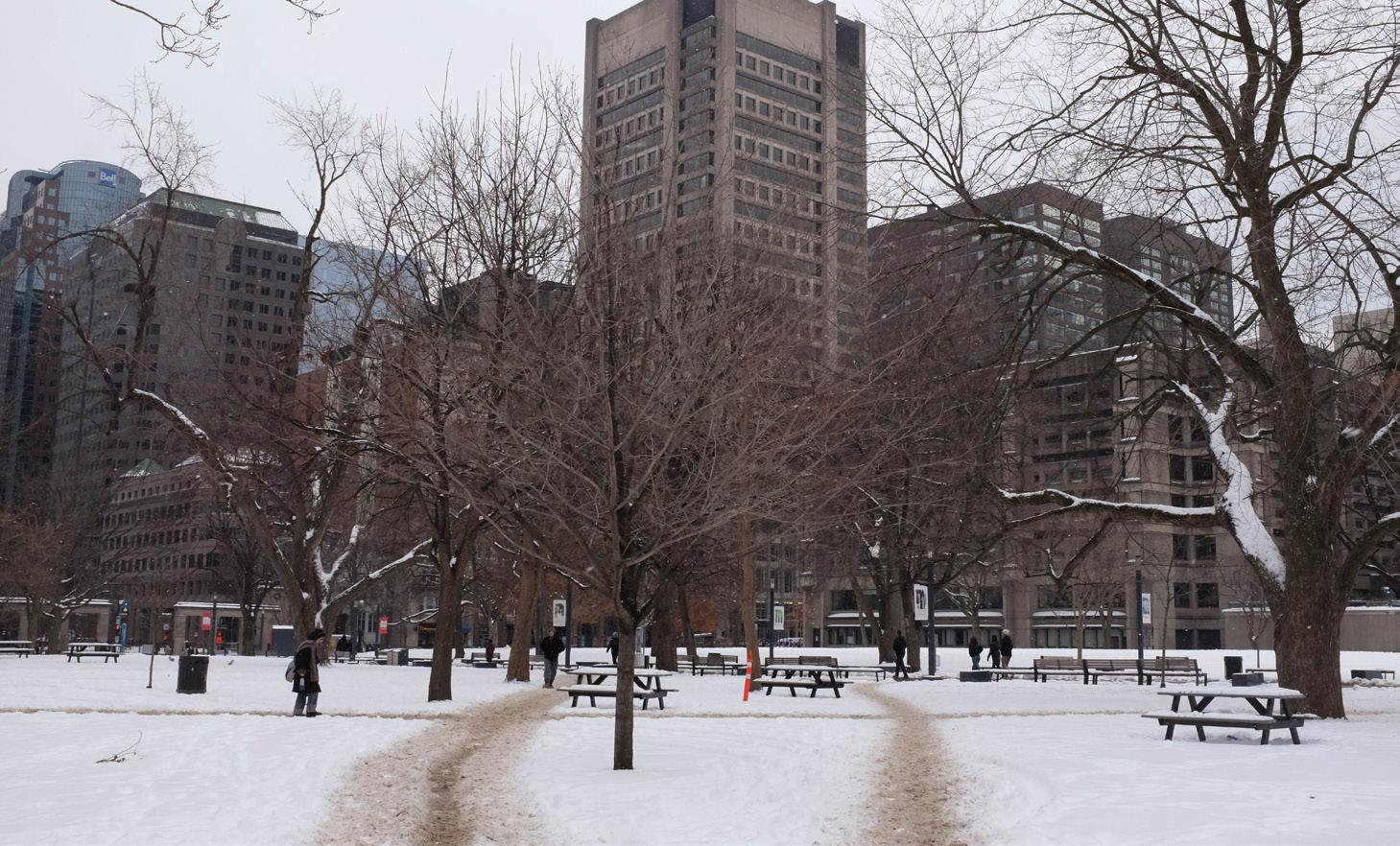
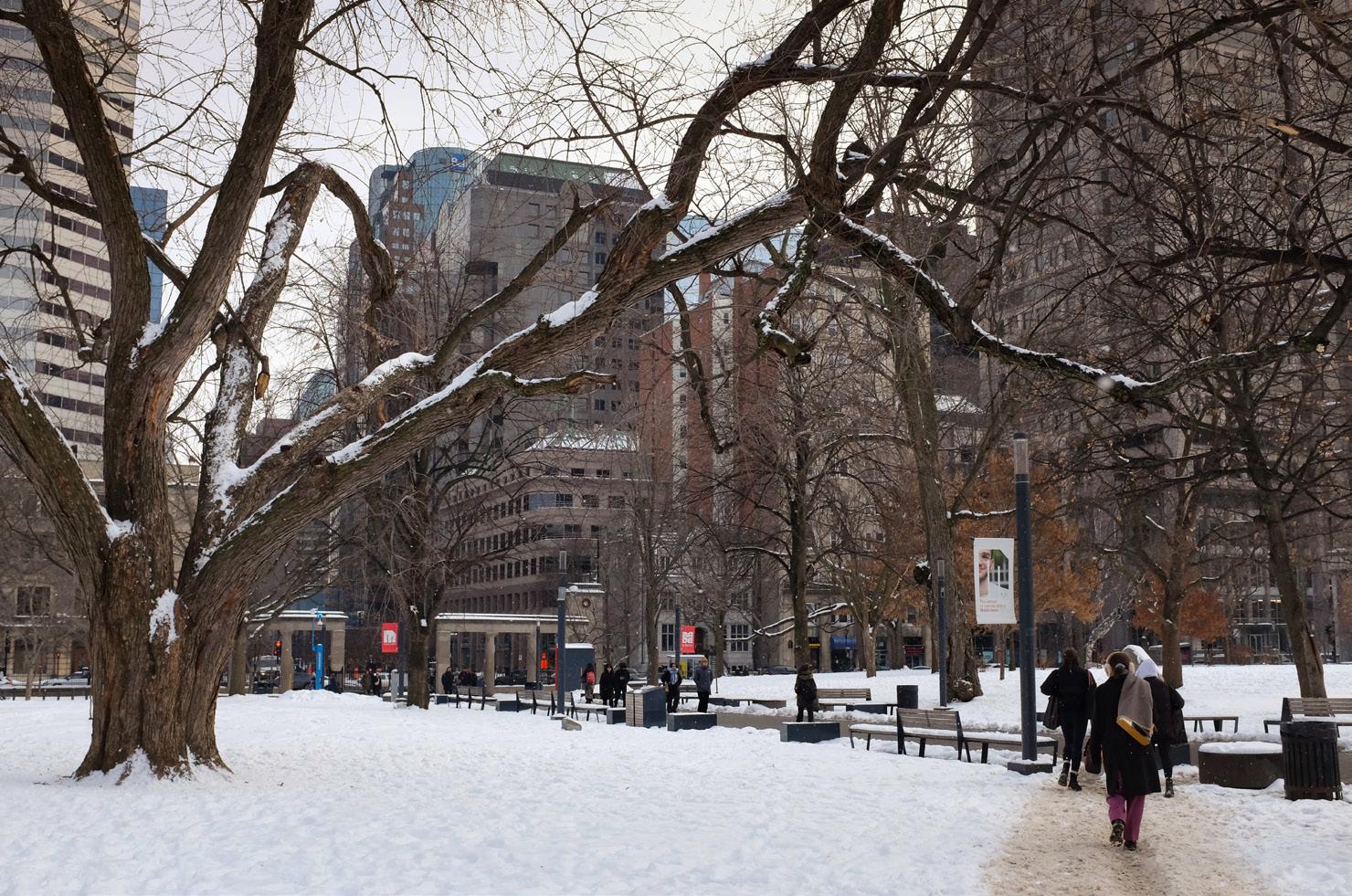
the meeting as they had been added to the agenda at the start of it, meaning that councillors had not had access to them prior to the meeting.
The meeting then turned to two discussion items. The first was in regard to PGSS’s decision to switch online healthcare providers from Dialogue to Maple. Member Services Officer Ambre Lambert explained that while the two platforms are comparable in services, Maple is cheaper per student.
GLSA Vice-President External Ajey Sangai raised the second discussion item as a last-minute addition to the agenda. Sangai explained that at the GLSA’s General Assembly in December, the group drafted a letter condemning McGill’s decision to ban speaker events on campus until the start of the winter term. In the letter, students argued that the action impeded students’ freedom of assembly and speech and they urged the university to better communicate the reasoning behind the ban. Students also wrote that the ban follows a pattern of poor communication on the part of the university, pointing to McGill’s emails surrounding the injunction against protests on campus around Oct. 7 this year as another example.
After a brief discussion on this subject, the Council voted on motions brought to the group prior to the meeting. Out of 12 motions, only four saw discussions on whether they ought to pass. In the end, every motion passed.
After nearly two and a half hours, the meeting adjourned at 8:53 p.m.
The first SSMU Legislative Council meeting of 2025 began with 18 out of 34 voting members present on Jan. 16.
Chief Electoral Officer Emma Chen began by addressing the low voter turnout in the past semester’s elections. Chen claimed that students did not believe ballot items impacted their lives, which led to disinterest in election outcomes and a subsequent lack of participation. To avoid nullified results due to a failure to meet quorum—as was seen in the by-election for the Vice-President (VP) Student Life and VP Sustainability and Operations roles on Nov. 29—Chen proposed SSMU becomes more proactive on social media to better inform
the student body of their vote’s impact and importance.
The council then discussed five proposed motions. First, VP University Affairs Abe Berglas moved the Motion Regarding the Internal Regulations (IRs) of Representation and Advocacy. The motion stands to revise and shorten the current IRs applied to committees on campus to give faculties more control over how and who is elected as a senator. When electing students to the McGill Senate, a group of councillors representing several committees across campus, University Affairs would take into account a candidate’s lived experience and identity. This would give preference to both students and senators most impacted by a committee’s scope when appointing positions of authority within the group.
Arts Councillor Ben Weissman questioned the rationale behind the removal of sections of the current IRs, and asked how the university would determine the extent to which a student is impacted by a committee’s subject matter. Berglas responded that only committees which serve a specific motion or demographic on campus would be subject to this motion.
“The Academic [Policy] Committee, we’re all impacted by that,” Berglas said. “But there’s some that are pretty specific [...] there’s a Subcommittee on Queer People, there’s a subcommittee on Black people; being part of those communities it makes sense would give you a leg up.”
VP External Affairs Hugo-Victor Solomon supported the motion, proposing a friendly amendment which added the caveat “if applicable” to exclude committees for which this regulation would be irrelevant.
When put to vote, the motion passed with 10 in favour, 3 against, and 5 abstaining.
President Dymetri Taylor put forward four other motions which were unanimously approved without debate: The Motion Regarding Interim Club Status for the Green Olive Chinese Christian Club, the Motion Regarding Constitution Changes for the McGill Students Chinese Music Society, the Motion Regarding an Interim Provision to the Internal Regulations of Student Groups, and the Motion Regarding Interim Provision for IRs of Elections and Referenda.
Editor-in-Chief
Jasjot Grewal editor@thetribune.ca
Creative Director Drea Garcia Avila dgarciaavila@thetribune.ca
Managing Editors
Yusur Al-Sharqi yal-sharqi@thetribune.ca
Shani Laskin slaskin@thetribune.ca
Ella Paulin epaulin@thetribune.ca
News Editors Eliza Lee
Kaitlyn Schramm Mairin Burke news@thetribune.ca
Opinion Editors Ellen Lurie Lulu Calame Monique Kasonga opinion@thetribune.ca
Science & Technology Editors
Coco Zhang Leanne Cherry scitech@thetribune.ca
Student Life Editors Auxane Bussac Malika Logossou studentlife@thetribune.ca
Features Editor Amalia Mairet features@thetribune.ca
Arts & Entertainment Editors Kellie Elrick Charlotte Hayes arts@thetribune.ca
Sports Editors Anoushka Oke Clara Smyrski sports@thetribune.ca
Design Editors Mia Helfrich Zoe Lee design@thetribune.ca
Photo Editor Hannah Nobile photo@thetribune.ca
Multimedia Editor Sahel Delafoulhouse multimedia@thetribune.ca
Web Developer Laura Pantaleon
Roberta Du webdev@thetribune.ca
Copy Editor Matt Adelberg copy@thetribune.ca
Social Media Editor Aliya Singh socialmedia@thetribune.ca
Business Manager Celine Li business@thetribune.ca









Arecent study revealed that discomfort among Quebec youth regarding friendships with 2SLGBTQIA+ individuals has doubled since 2017, highlighting an alarming rise in anti-2SLGBTQIA+ attitudes in the province. A broader, growing shift toward conservatism has fueled this surge in intolerance and serves as a threat to the safety of 2SLGBTQIA+ people. Homophobic microaggressions and casual transphobia are increasingly common, often perpetuated by online “alpha male” content creators and their “antiwoke” rhetoric. The corresponding resurgence of traditionalism, a trend rooted in modern economic instability and nostalgia for the rigid norms of the past, scapegoats 2SLGBTQIA+ individuals and makes meaningful discourse on their rights—in Quebec and abroad—taboo.
At McGill, the growing momentum of conservatism and anti2SLGBTQIA+ attitudes has coincided dangerously with the temporary leave of Dr. Hashana Perera, who is reportedly the only doctor at McGill’s Student Wellness Hub (SWH) willing to provide Hormone Replacement Therapy (HRT). HRT is a critical form



Drea Garcia Avila Creative Director
Over the course of my 21 years of life, I’ve lived in nine different houses/apartments; three countries; five cities. But until recently, I couldn’t tell you if I’ve ever lived somewhere I’d call home.
By Merriam-Webster’s definition, “home” refers to one’s place of residence, and also as “the social unit formed by a family living together.” I had the luxury of living in various places and growing up comfortably. I never lacked the essentials, and I was given every opportunity to explore my interests
of care that allows individuals to align their physical selves with their gender identity. Perera has also identified gaps in support for transgender students at the university, making her presence crucial to the well-being of 2SLGBTQIA+ individuals. In her absence, students seeking HRT face referral to the Hygea endocrinology clinic, where wait times can be up to a year long.
The fact that gender-affirming care at McGill relies on a single doctor is particularly egregious, as it creates a precarious system where a single practitioner’s leave disrupts access for the entire student body. Furthermore, even when such staff are available, McGill’s health insurance policy requires 2SLGBTQIA+ students to jump through unnecessary hoops to access care for treatments, even outside of HRT. For example, diagnosed gender dysphoria is a prerequisite for most gender-affirming care, but few doctors are willing to provide this diagnosis.
The lack of urgency and support, compounded by an overloaded SWH, forces competition for appointments, exacerbating financial strain and hindering students’ ability to engage fully with their communities. Even once students are finally able to access treatments, the costs—including those


of repeated HRT or gender-affirming surgery—are not fully covered by insurance.
The fragility of the genderaffirming healthcare system reflects a lack of institutional commitment to equity and inclusion. To truly serve its 2SLGBTQIA+ students, McGill must do more than vocalize its support; it must listen to organizations advocating for gender-affirming care and invest in training more practitioners, expanding healthcare access, and addressing systemic barriers across the board. The university must enforce protections against transphobia, deadnaming, and discrimination to create an environment where all students feel supported.
McGill’s Public Health Masters program also plays a critical role in this process in their duty to prepare future healthcare professionals to work inclusively and effectively with diverse populations. Students in this program should be trained not only to provide sensitive care but also to identify and challenge implicit and explicit biases that uniquely impact the health of marginalized communities. Courses on medical racism, transphobia, homophobia, and implicit bias should be core components of the curriculum, even starting at the undergraduate level.

Healthcare students must be taught how to engage with patients in vulnerable moments and to advocate for policies that ensure equitable care. This interdisciplinary approach, which combines technical skills with social and ethical considerations, will better equip future healthcare professionals to address the complex needs of 2SLGBTQIA+ individuals.
Gender-affirming care is not a luxury; it is a right that can save lives, allowing students to feel like themselves and succeed in school and beyond. Until the university prioritizes employing more doctors capable of offering gender-affirming care, offering further guidance for accessing this care, and expanding insurance coverage to these treatments and procedures, the SWH will remain an unreliable and inequitable healthcare provider. This moment calls for collective action to address the barriers faced by 2SLGBTQIA+ communities and to counter rising anti-2SLGBTQIA+ biases through education and advocacy. By fostering a healthcare system and campus culture rooted in inclusion, awareness, and solidarity, McGill can combat rising intolerance and, in turn, pioneer meaningful change for its 2SLGBTQIA+ community, and that which extends beyond McGill’s gates.

and identity with my parents’ unwavering love and support.
But there’s always been a gap. When my friends talked about their long-standing relationships with their friends and families—visiting grandparents over the weekends, spending holidays with their extended families—I knew this would never be an experience I could share. Moving around as much as I did, the idea of being best friends with my cousins or living next door to friends for so many years that we basically became siblings wasn’t feasible for me.
For all these types of interpersonal relationships, I generally knew but one: A promising—but casual—new friendship cut short by my family’s next move. Though it is now possible to keep in touch over social media, this option was not one I had access to as a child. Besides, nothing comes close to in-person connection; over time and separated by a phone, it seemed my presence in my extended family’s and casual friends’ minds would eventually fade.
Every move, I would make new friends, and after a couple years, we would move again. I felt a piece of myself stay behind with every changing town. Until I was a teenager,
I felt like no one cared about me as much as they did their other friends; and how could I blame them? I wasn’t physically there.
My heart has been separated into so many segments, each one being left in different regions and experiences with people who I’ll never see or meet again. So how can home be where the heart is if my heart is fragmented into all these pieces?
If I could never stay in one place long enough to establish a home, what was the point in relentlessly trying to make one? As a result, I avoided overpersonalizing my spaces, knowing it was but a few years until I would have to tear down the decorations and repaint the walls. Establishing intimate connections felt similarly futile, as I would eventually have to tear myself away from everyone I’d met anyway.
As a student and an immigrant, I’ve always felt like I didn’t quite belong anywhere I went. So I’ve had to learn to find the feeling of home in places other than my residence— I’ve been searching for it in the love around me.
The compassion and love my friends and family have shown me created a home in themselves. My


friend and her mom once drove 16 hours total from Toronto to Stamford, Connecticut for a weekend visit; my Whitby friends have driven up to Montreal at least twice a year for nearly four years now. With sleeping bags and air mattresses sprawled on the cold floor of my tiny studio apartment, I’m reminded that I’ll likely never find friends like these again.
Though my scenery changes constantly, I will always cherish my chosen family.
So why should I deprive myself of the joy of having a home that’s my own, filled with colourful ceramic dishes, thrifted crystal lamps, and the laughter of my loved ones? With every hand-me-down from my family, personal trinket, or thoughtful act from my friends, I bring a bit of everything—and everyone—I’ve experienced into every place I go, and, in the process, I leave a piece of myself in every place I’ve been.
With my turbulent living arrangements, I felt like I would never know stability and community; but, with every year, I’m thankful for the tumultuous moves, as every step has been bringing me closer to something that I might someday call home.



Abe Berglas Contributor
In its Dec. 4 issue, The Tribune published a review of the Post-Graduate Student Society (PGSS) executives The Editorial Board reported on Secretary-General Satish Kumar Tumulu’s lack of initiative (“he has yet to take concrete steps to improve channels for executive and student communications”), but followed it with an uncritical quote from Tumulu about lack of initiative from students to voice opinions about divestment, the Association of McGill Professors of Law (AMPL), or Association of Graduate Students Employed at McGill (AGSEM).
Advocacy on these topics has been energetic, consistent, and well-documented. This fall, a motion was submitted to the PGSS’ General Meeting calling
for the PGSS to share the Expression of Concern about Israeli companies among all its members. The motion presented on the agenda was changed without the consent of the mover to insert defense of McGill and remove ‘Palestine’ from the title. At the General Meeting, an amendment was made to revert the motion back to its original form and the motion was approved. But after this approval, Tumulu said in an email that executives will not enact the motion. In the same email, he redefined the role of a General Meeting, saying it should only concern itself with financial statements, governing documents, appointments, and removals. This contradicts the spirit of a General Meeting, and also the description on PGSS’s own website, which states, “[t]he General Meeting is the way for members to directly participate in the decision making processes for the society that represents graduate students [...] you can



also submit agenda items on topics that YOU think are important”.
Meanwhile, the approach PGSS has taken towards AGSEM has been antagonistic. The PGSS provided AGSEM with no support during the strike and refused to let AGSEM put up posters in Thomson House. A PGSS member told me they were expelled from a funding working group after being accused of sharing financial information with AGSEM, without being told what information was supposedly shared.
It does not take in-depth research to reveal the struggles for democracy at PGSS during Tumulu’s term, and I wish the students who have been fighting to be heard at PGSS were acknowledged in the Tribune’s reporting. The Tribune Editorial Board should welcome graduate students to its team, and pay attention to voices that are marginalized by the PGSS’s institutional power.
An article published in the January 14, 2025 issue (“SSMU BoD debates gender-neutral washrooms at first meeting of 2025”) state d that General Manager Maya Marcus-Sells expressed uncertainty about the motion’s adherence to Quebec building code. In fact, Marcus-Sells argued that she believes the motion is in adherence to building code and health and safety provisions. The Tribune regrets this error.
Rhys Jones Contributor
our days of activities, DJs, and early rises is a serious undertaking at the end of your summer holidays. Some outsiders raise eyebrows when told that’s how McGill readies students for university life—and yet it sets the tone perfectly for our degree. What better way to work out how many nights you can handle on the trot and still function the next day? Who better to introduce you to student life than upper-year students who’ve been in your shoes? Of course, Frosh wasn’t perfect for everyone, but those who declare that it inculcates a toxic culture of peer pressure and alcohol couldn’t be more wrong.
Frosh has changed with the times and does a great job of ensuring that the almost 5000 students who partake in the orientation week can move at their own pace. As a first-year, I did Frosh sober (loved it), and became a Frosh leader this year. About half of my froshies hardly touched a drink all week, enjoying the opportunities to dip their toes in Montreal nightlife, make friends over a game of beach volleyball, and explore the city.
This contrasts with a crew of Québecois first-years I bumped into at the Mont-Royal viewpoint on a morning run back in October. They told me they were doing “scunts”—a portmanteau of “scavenger hunts”—to earn points for their team in one of McGill’s activity weeks. These students had read ahead in their classes so they could spend their day running up mountains, taking shots, and all sorts of other chaos. They told me that so far, it had been the best fun they’d ever
had.
One might wonder how it can possibly be in the interest of those students to miss two lectures to spend a day doing silly drunken challenges. However silly as they might seem, these activities play an important role in establishing community, making friends, and having a good time. A McGill degree isn’t easy, but that doesn’t mean students should chain themselves to the library year-round.
Beyond the classic “you’re only young once” argument—though it is true that you’re not going to be able to squeeze out a 2000-word essay the day after getting home at 3 a.m. forever— life doesn’t get any less busy. Being able to balance academic deadlines with whatever else you enjoy is a vital skill, whether that means getting involved in Intramurals, acting in a play, or running a club—whatever piques your interest. What’s important is making time to do anything other than your essays—if not for the sake of your mental health, then at least for the sake of having something to talk about besides that professor.
A student bar like Bar des Arts (BDA) might not immediately appeal to everyone, but the excitement on the faces in its line reveals that it’s doing a hell of a good job providing respite for stressed McGill students. Frosh and scunts may look like academic self-sabotage, but the 4.0 GPA of the sorority girl who goes out every night (as per the transcript posted on her Instagram for 150 scunt points) evidences the patently obvious truth that McGill students are capable of scheduling their work and their play.
Some will take it too far and drop a few marks, as has been the case since the
dawn of time, but that’s a lesson we all must learn. University is more than simply ensuring you nail your calculus test or can perfectly outline the realist perspective on nuclear proliferation. It’s about learning self-discipline, giving yourself the broad base of experiences you need to tackle an evolving world, and working out who you are. At the end of the day, university is where you make the most of your newfound freedom. Which will you regret more at 30: Dropping down to an A- on POLI 244 because you failed to squeeze in those last couple of readings between a soccer game and a power hour, or having never made the memories at all?

Zoya Mirza Contributor
While the snow is beautiful, the frigid temperatures and grey skies can make it easy to give in to laziness and just stay home watching lecture recordings in pyjamas. However, we can bring the coziness of our living rooms out into the cold, wintery streets with a piping hot spiced beverage! This week, I visited six of my favourite cafés near campus to determine which has the best wintery, joyful seasonal drinks.
Café Humble Lion - White chocolate latte
Before I begin this review, I should say that I’m not the biggest coffee fan in the world, so this may rank lower for me than it would for most people. This coffee was good, although they could have gotten more creative with it. It tasted exactly what one would expect a regular latte with white chocolate syrup added to it to taste like. However, because this cafe is close to campus—and the fact that this was still a pretty solid coffee—I would come again. I think they could have levelled this up by adding peppermint or something nutty to the mix, but one can still appreciate the simplicity and quality of a good Humble Lion latte, and I could never turn down the little added sweetness of the white chocolate flavour.
Overall rating: 7/10
Jeanne Le Roux Contributor
DIt was good. I’m ready for better.
Edmond Café Cantine - Orange hot chocolate
I walked into this cafe and asked for their best seasonal winter drink. The barista consulted another barista to prepare a special citrus-themed drink that was not featured on the menu. I do not kid when it comes to chocolate, so I was very excited. After trying it, I noted that it was creamy, and had a buttery, deep chocolate flavour. The orange was very subtle (maybe they forgot to add it?), but it still managed to be one of the best hot chocolates I’ve tasted in Montreal—and the café’s ambience gave it extra brownie points!
Overall rating: 9/10
Café Saint-Barth - Hot chocolate
This cafe is much closer to McGill than some of the others, and its ample desk space and cute decor make it a great study spot. The hot chocolate itself was adorable and delicious, topped with plenty of whipped cream, although it tasted a tad watery. While I would recommend the Edmond hot chocolate more, the convenience of this location boosts its rating.
Overall rating: 9/10
Che Churros and Empanadas - Hot chocolate
This hole-in-the-wall empanada shop in the Plateau is a personal favourite of
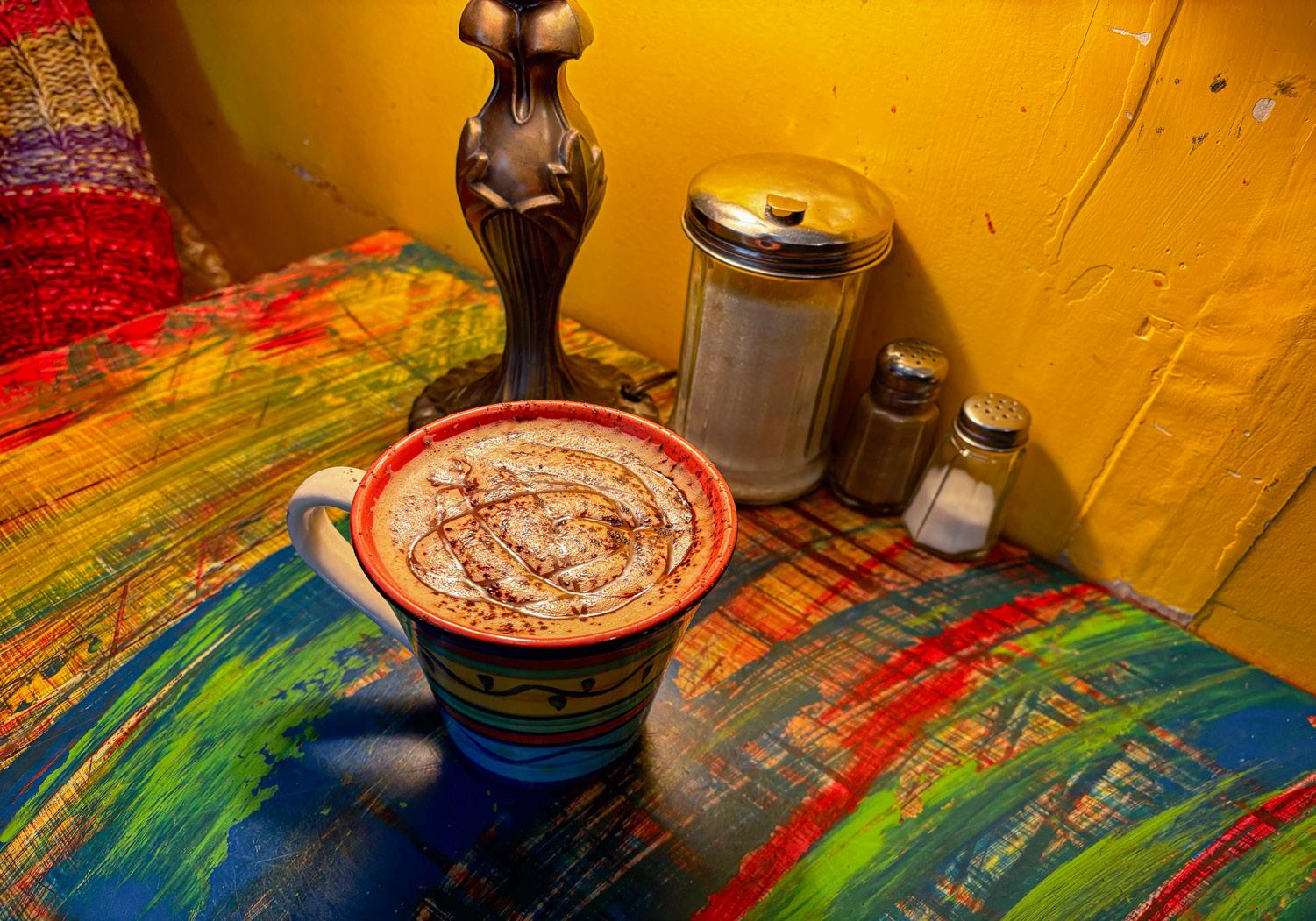
my roommates and me. I ordered their hot chocolate, which they only serve during the winter season. It was gorgeous— complete with colourful marshmallows, chunks of peppermint, dolloped whipped cream and sprinkles. What more could you ask for? Unfortunately, the hot chocolate was far too milky for my taste, feeling more like an over-decorated hot glass of milk. While the hot chocolate did not deliver, their empanadas and customer service are top-tier, so I will be going again.
Overall rating: 5/10
Le Darling - Dirty chai
Sometimes you just need a hot, cozy, spicy chai, and some caffeine to get the work done. I enjoyed this drink and highly recommend having a little study session at Bar Darling. The quirky furniture and mood lighting is chef’s kiss and there is plenty of space to spread out your belongings. Now, when it comes to their coffee, they know how to do it right. It’s classic, delicious, and the service is incredible.
Overall rating: 9/10
espite all the snow January brings, many students are eager to return to campus in the new year and start fresh. For many students, New Year’s resolutions mean a commitment to participate in new campus activities that they have not tried before. Looking forward to activities ranging from joining clubs to attending events like OAP, students seem determined to be a part of campus life in 2025.
Sean Overton, U0 Engineering, for one, is planning on being more involved in campus life by joining clubs this semester. For Overton, the Winter semester offers a chance to create a new routine.
“Now that it’s the second semester, I am more used to managing my time so I want to join even more clubs,” he explained in an interview with The Tribune
The recent reopening of Gerts is another boon for students looking to engage with the community in one of McGill’s classic third spaces. Eleanor Casey, U1 Arts, expressed her enthusiasm for the student-run bar.
“Especially in the winter when I don’t really feel like going too far or trying out new places, Gerts is always a nice place to go to,” she said.
Other campus bars like Bar des Arts (BdA) and Blues Pub are

places that McGillians are looking forward to attending in 2025. Especially with the cold winter weather, the affordable food and drinks combined with the lively environment make these fun and welcoming spaces very popular amongst students.
Blues’ layout enables people to move more freely around without constantly feeling claustrophobic, which is one reason why so many students love it.
“Blues has really good grilled cheese and since it’s a circular area it’s very accessible,” Ella Bjork, U1 Arts, highlighted.
Exploring campus does not only mean hanging out downtown: Many
downtown-campus pupils tend to forget that the Macdonald campus also has its hidden gems.
“I really want to visit the Macdonald campus because I heard it is very pretty in the spring with all the flowers,” Casey said.
This year, McGill students are committed to explore campus more, although they are also looking for fun places that allow intellectually stimulating activities are also welcome in 2025. Bjork explained in an interview with The Tribune how visiting the Redpath Museum is a must.
“There is a lot of natural history, animals, rocks and shells. Coming from an
Art History major, I really recommend it because it’s very rich with history,” Bjork stated.
Bridget Cohl, U2 Engineering, cannot wait to be able to relax and hang out on the Lower Field when spring finally arrives in Montreal—a feeling that is shared by many students eagerly awaiting the warm weather and the return of the hot dog man.
“We have a really pretty campus to just sit around in summer or spring to read a book or talk to friends,” said Cohl.
“I love getting a hot dog on a warm day and sitting on the grass of the Lower Field,” added Casey.
The St. Patrick’s Day celebrations such as the Ginger Run and dressing up all in green to wait in line for a drink at concerningly early times in the morning are also impatiently awaited by students.
Finally, Open Air Pub (OAP) is a classic McGill way to cap off the semester on a good note, with some live music, cheap beer, and good vibes.
“I am really looking forward to going to OAP if I don’t have too many finals and I am also very excited for St. Patrick’s Day,” Cohl said.
The McGill campus has a lot in store this year for students looking to get involved. Be sure to keep an eye out for upcoming opportunities and events and make the most of your campus experience.
When I first moved to the what felt like every store I went to. Microbreweries are very visible in the neighbourhood. You can find their fare all over the place: Be side the register on coffeeshop counters, through the win dows of Lejeune & Frères on Duluth, piled high in dépanneurs. I remember the first time that I visited the Intermarché on MontRoyal; I was surprised to turn the corner of the store’s final, narrow aisle and find a wall of brightly-coloured cans staring back at me.
It can be easy to see craft beer as just another can on the shelf, but I wanted to go a step further and explore the possibili ties microbreweries might open up for reorganizing our society. In an increas ingly atomized world where large compa nies dominate over small businesses, how might microbreweries present other ways of relating to workers, communities, and the environment?
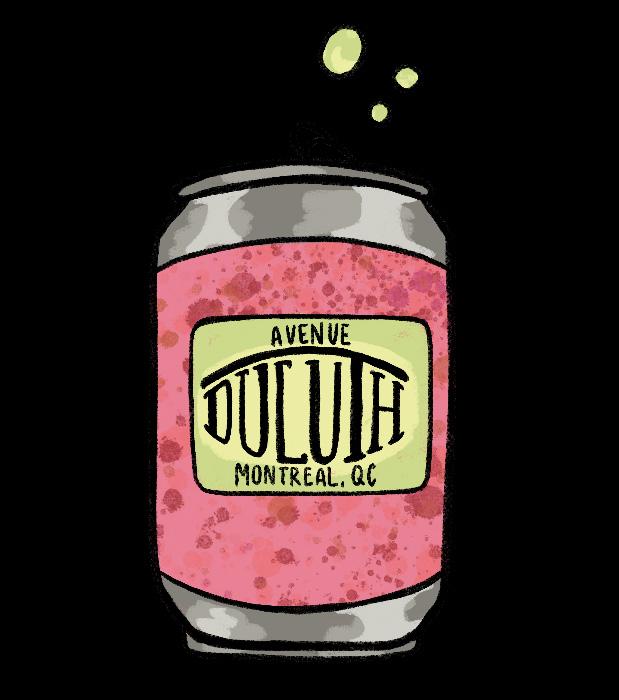
L’Association des microbrasseries du Québec (AMBQ) is an organization that aims to support the work and represent the shared interests of member microbreweries to the government. Éric Grypinich, a project manager at AMBQ, explained in an interview with The Tribune that an tant feature that sets microbreweries apart from larger ones is the sense of passion that brewers bring to their product. Grypinich believes that this passion not only enhances the beer itself, but also serves to better connect breweries to their workers and cus -
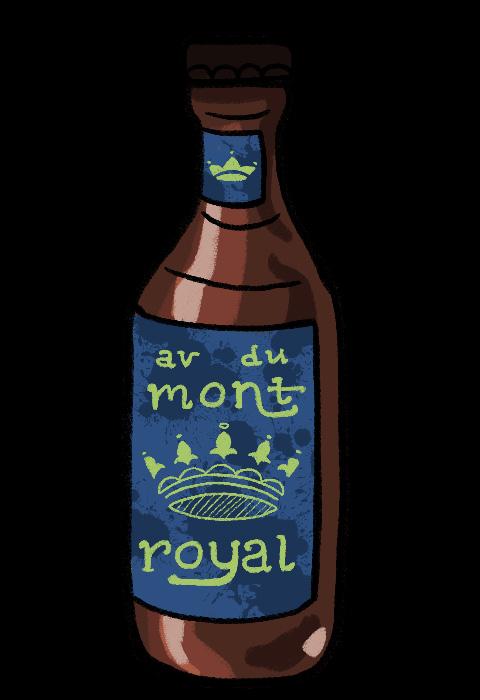
“The passion is felt in the quality of the beer, in the way that we talk about beer, and how we engage about people,” Grypinich said. “You go to a brewery, you go see the brewers. They’re always proud of their product. They’re always talking about beer, and [...] relating to people [....] Because we’re not into mass marketing, so our best marketing is how we get in touch with people.”
Club Haley Janvrin, U4 Engineering, and Laura Hebert, U5 Engineering, the intention that goes into craft beer is a key takeaway from their time with the club. The group brews small batches of fermented drinks like beer, wine, and kombucha and regularly partners with microbreweries in Montreal for events. Most recently, the club participated in Saveurs de Génie, a competition at l’École de technologie supérieure where students create a recipe and collaborate with a local microbrewery to brew it. The McGill club’s brew—made in partnership with Benelux—will soon be available for purchase in the brewery’s location on
Janvrin and Hebert told that getting the chance to learn about how to achieve certain flavours through the brewing process is a highlight of working with microbreweries. In this way, the craftbeer-tasting experience stands in contrast
thing that Anne Claude Thivierge, a sales representative and event coordinator at Microbrasseries COOP, emphasized in an interview with The Tribune ries Coop is an association that supports cooperatively owned microbreweries in Quebec. The group is a part of Réseau COOP, a larger network that promotes cooperatively-owned businesses (coops) and offers resources to help create them.
As Thivierge pointed out, micro breweries frequently collaborate to organize events and brew beers together. Many also source local produce for brews or for food at restaurants attached to their breweries. She noted that having a cooperative structure further connects a brewery to the lo cal community in several ways: Sharing decision-making pow er amongst workers, provid

“It’s a lifestyle”:
craft beer, Quebec,
Written by Eliza Lee,
to beer consumption at many other student events, where the priority is often drinking large quantities of brew for cheap.
“I think we’ve come out of it with a much better understanding of not only the work that goes into beer, but how what you do really changes the flavour of it, and how it creates this kind of experience of tasting beer, as opposed to, say, binge drinking,” Hebert said. “I think it’s given me more of an appreciation for the beverage, and also an appreciation for the [microbrew ery] community.”
“If the craft beer drink ers saw someone chugging a craft beer, they’d be like, ‘Oh my God, what are you do ing?’” Janvrin said later on. “‘You’re wasting the good stuff.’”
“It’s
a
life style”
The sense of community Jan vrin and Hebert discuss is some
Editor & Designed
est.
ing livable wages, and allowing employees to reinvest their earnings in other local businesses. Thivierge stressed that supporting the community is a crucial value for coops.
“It’s not only beer, it’s what beer is made with, and it’s how the profit or the wealth generated can provide salaries, and it also make other local businesses benefit from the dynamism that it brings to a community,” Thiv -

For Vice Presidents of McGill Brewing

“It’s not just alco -
For small communities, breweries do not only draw local residents together, but they also bring visitors to the area. Crowds of visitors come to St. Tite each summer for Festival Western, but Thivierge believes that local breweries such as À la Fût can also bolster the community economically throughout the rest
“It’s amazing to see that the
breweries sort of have replaced the church, where everybody would gather and meet one another,” Thivierge said. “Breweries have this role as well in smaller communities in this gathering

These appeals to the local community can also affirm their authenticity to consumers. Daphne Demetry, an associate professor in McGill’s Faculty of Management who studies organizational authenticity, explained in an
The Tribune that authenticity hinges on the notion that “an organization’s claims align [...] with what they are actually doing.” Demetry also confirmed that appealing to a sense of local identity is a “major” way many businesses
follow the coop business model. Thivierge went on to explain that one of the mandates of the Réseau Coop is to promote coops as a viable business model, not just as an “alternative” model chosen by few businesses and often overlooked at business schools.
“[The coop model] goes well with values that [microbreweries] already have,” Thivierge said. “They just don’t know that there is a structure that would allow them to be [consistent] in their business structure.”
At the same time, Thivierge stressed a distinction be tween microbreweries and what she calls “fake craft breweries.” These businesses owned by large beer companies are designed to appeal to the val ues that craft beer espouses de spite their lack of commitment to community, such as by brew ing products outside of Quebec.
“The small craft breweries al ways try to educate the consum er, to say, ‘Well, it’s not only about drinking a good IPA. It’s about a beer that also brings wealth to a
earn this attribution from consumers.
“Terroir and wine is a classic example,” Demetry wrote. “The idea is that a product gains some sort of ‘essence’ from a lo cation.”
According to Grypinich, it’s this sense of community and love of brewing that motivates people to continue working in the indus try, despite the increas ingly crowded beer market in Quebec; in 2002, there were just 33 breweries in the province. In 2024, there were 332.
“Unfortunately, there’s no money [in the market] [….] but there’s some friendship. There’s a way of building your life and having satisfaction to wards brewing nice product, the community that supports you, your family, your friends,” Grypinich said. “It’s a lifestyle, basically.”

“One thing that they share a lot is, ‘What do you do to make your water with chemicals easier on the environment in the city water installation?’” Thivierge said. “There are ways to [dispose of] less chemicals, either by using them more than once, or by neutralizing the chemicals before putting it back into the environment.”
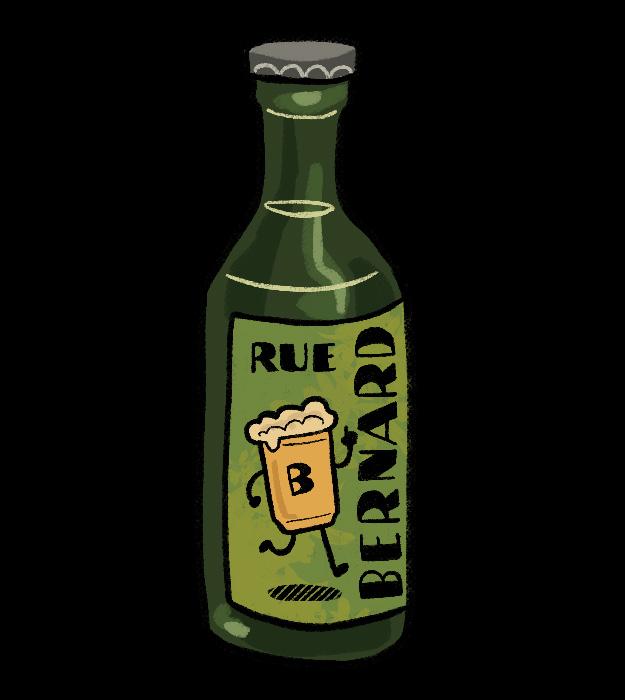
For Grypinich, a commitment to sustainability is a key way that microbreweries distinguish themselves from larger breweries. While the latter simply seek to stay within government parameters, Grypinich believes microbreweries take more active steps to minimize their environmental footprint. Among the AMBQ’s sustainability efforts is an initiative which allows microbreweries to use 500-millilitre reusable glass bottles instead of aluminum cans, cutting down
“We have internal committees that are really working on the process and helping all the microbreweries to be better,” Grypinich said. “There are many gestures that you could do to lower your emissions, even though you’re
It’s about willingness to make a differ-
community that is respectful of sustainable development and that has care for the people that make the product.’”
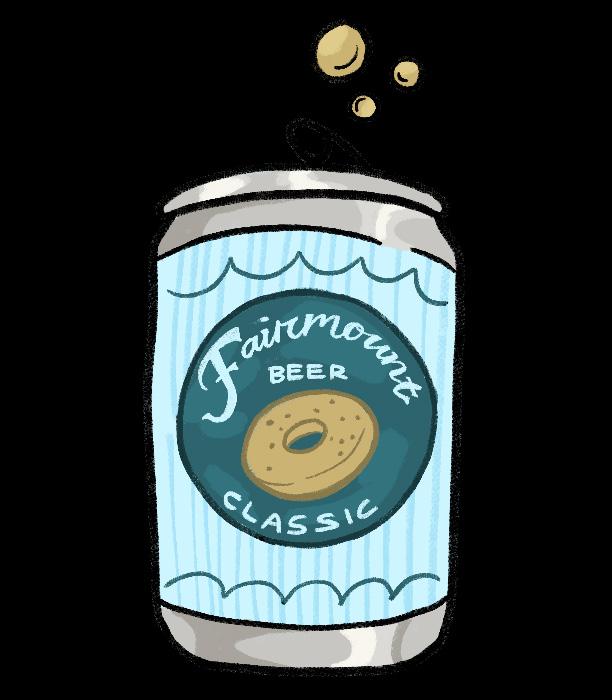
Many microbreweries reflect the same community-oriented values, though not all
Thivierge noted that among the microbreweries Brasseries Coop represents, environmental efforts can differ depending on their unique needs. Les Grands Bois, located in Saint-Casimir, limited the brewery’s transportation emissions by increasing their warehouse space. La Chasse Pint in L’AnseSaint-Jean uses heat produced by the compressor during the brewing process to warm the brewery during winter, diverting this heat from the building during the summer.
Breweries also share strategies for common sustainability dilemmas. One example concerns how breweries dispose of cleaning chemicals that may harm the environment if sent directly down the drain.
This is not to say that microbreweries are idyllic, communal fantasy lands where people can escape the realities of neoliberal life. Microbreweries cannot fix our world’s growing wealth disparity or solve climate change. However, in prioritizing local engagement and sustainability, they normalize alternative ways of doing business that foreground responsibility and prioritize care for workers, the com munity, and the environ ment. These values even go hand-in-hand with business models based on collective ownership, which stand in stark con trast to the nested subsidiaries you might find with big beer compa nies. Considering this, perhaps we can look to mi crobreweries for ways to move to wards broader, more just social and economic arrangements.

The work of craft breweries, then, is not just visible on the shelves of coffeeshops, grocery stores, and depanneurs— it’s in the streets.
Jamie Xie Staff Writer
Over the holiday, I visited the New York Public Library’s Polonsky Exhibition, a permanent collection of “treasures” that includes the original Winnie the Pooh stuffy—a surprisingly familiar Farnell Alpha bear model donated by Christopher Robin himself. Though nearly a century older, the plushy beared resemblance to my own childhood teddy. While we think of time as fixed in sepia tones, the reality of history is dynamic—relentlessly and perpetually “in the happening.” Stuffed animals have always occupied the heart-shaped, rose-tinted blindspot in our rearview mirror, capturing moments of sentimentality that transcend time.
Though Richard Steiff of the Steiff company made the first stuffed bear in 1902, they had not come to be known as “Teddy Bears” until a historical moment involving renowned sportsman and American president Theodore Roosevelt. Roosevelt had gone on a bear hunting trip in Onward, Mississippi, with Governor Andrew Longino. While many people in his party managed to find game, Roosevelt was down on his luck. Hoping to uplift the president’s spirits, the group’s guides captured a bear to present to him. Upon finding the defenseless bear tied down to a tree, Roosevelt refused to kill the animal, declaring it unsportsmanlike. His act of mercy was
quickly immortalized in newspaper headlines and political cartoons. The bear, depicted as increasingly small and more endearing with each iteration, perfectly framed Roosevelt as a tenderhearted, everyman-father archetype. Inspired by Clifford Berryman’s Washington Post cartoon of the story, Morris Michtom, a Brooklyn candy maker, manufactured a popular series of toy bears called “Teddy’s Bear” in honour of Roosevelt’s compassion.
Stuffed animals surged in popularity around the Great Depression, when resources were scarce and the United States grappled with widespread economic hardship. Unlike the utilitarian woodblock toys typical of the time, plushies offered something more human: Unconditional love, soft solace and a friendly face—a much-needed emotional refuge from the harsh realities of a then-insecure world.
Today, stuffies occupy a similarly special, bear-shaped hole in the hearts of students navigating the pressures of academia. For science students especially, balancing rigorous coursework, intensive labs, and the emotional weight of studying a world in perpetual crisis can be overwhelming. Sukaina Haider, U0 Science, suggested that these challenges make moments of plush respite all the more necessary.
“In science, we’re going through the trenches. I think if anything, we’re more inclined to run home to something comforting,” she said in an interview with The Tribune
Jorey Alharbi, U0 Engineering, reflected on how their beloved teddy bear brought familiarity and sentimental warmth to their bare-walled dorm room.

“I don’t have a lot, just one big teddy bear that my grandmother gave me before she passed. It’s the first thing I move; it helps establish home,” they shared.
It’s integral to recognize that stuffies aren’t just inert toys—they’re transformed by the process of play. Naiya Delprat, U2 Arts, has a massive collection of 106 stuffies, nearly all named—of which she brought 28 from New York to Montreal.
“When you play with your stuffies they become your friends, you never outgrow your friends,” she said.
For some, stuffed animals provide a sense of companionship. Grace Caldwell, U1 Arts, reflected on her relationship with her stuffies, highlighting that wanting the best for them is a form of self-care.
“I feel like we take care of each other,”
Simona Culotta Contributor
Whether you’re a returning McGill student, starting your first semester, or visiting on exchange, Montreal offers endless activities, festivals, and places to explore—even during the cold winter months! Diving into these experiences is a fantastic way to discover the city’s unique character, especially for newcomers.
Montreal is renowned for its festive winter entertainment, with Igloofest standing out as the iconic January-February event. The festival attracts people across Canada to the Old Port for lively performances, international music, food, drinks, and an energetic atmosphere in a unique harbourfront setting.
Joshua Farmer, U1 Arts, called Igloofest a top winter highlight and a “mustdo” for students in an interview with The Tribune
“Not everyone comes from a place where they experience seasons, so when you are spending a night out in the snow with other people, it’s a super festive and seasonal way to enjoy the winter,” Farmer said.
Igloofest not only celebrates winter but also offers a great first impression for students who’ve never experienced it. Farmer noted that the festival is a great way to meet people, with students attending from both local and distant places, highlighting its welcoming social atmosphere for newcomers to McGill.
While Montreal festivals like Igloofest

are a rite of passage for students, they’re not the only ways to embrace the fun side of the winter season. Farmer emphasized how shopping during this time of year offers distinct advantages.
“In Montreal, winter is a good time to go vintage shopping and thrifting because everyone has donated their old clothes after getting new items from Christmas and the holidays—so I think that’s a really good time to dig through bins, hit the boutiques, and get some good new finds,” Farmer said.
Eleanor Casey, U1 Arts, enthusiastically shared her love for thrifting as a fun winter activity. She listed some recommendations in an interview with The Tribune
“Renaissance is my favourite place to thrift, especially for winter apparel. You can find great jackets and layers at Renaissance, Salvation Army, and Eva B. on St. Laurent,” Casey said.
Conveniently, these thrift stores in the Plateau and Mile End area happen to be surrounded by cafes and restaurants filled with aesthetic decor and great ambiance. Sean Overton, U0 Engineering, talked about how much he enjoys the wide range of food options and cafes to visit in the area, specifically on Ave. Mont-Royal.
“L’Avenue is one of my favourite restaurants on Mont-Royal and the Huevos Rancheros is my go-to meal that I recom-
she told The Tribune. “A stuffy is a false hug and real hope. Every kid should have a stuffy, whether or not you want to hold onto it is your decision, but everyone is entitled to comfort.”
Born and raised in Winterpeg, Manisnowba—where the grass isn’t quite greener, it’s probably just dead or dying—I’ve always had a soft spot for Winnie the Pooh. Named after her Manitoban caretaker Harry Colbourne’s hometown of Winnipeg, “Winnie” was a real black bear who served as the inspiration for Christopher Robin’s stuffed animal, and the timeless children’s character it became. The humble origins and international success of the character along with all its plush peers represent a whispered promise: Even the smallest things in life have their way of leaving a mark on this big world.
mend everyone should try,” he said. Another great outdoor winter activity for McGill students to partake in is ice skating.
“It’s a low-cost activity you can do with your friends, especially if you own skates— it’s free if you bring a pair at locations like Place des Arts, Mont Royal, and Parc La Fontaine. It’s a great way to enjoy the outdoors without feeling too cold, thanks to the exercise from skating,” Overton said.
While meandering through shops and cafes or skating outside in parks are all amusing ventures and ways to enjoy the city, Montreal’s famously freezing temperatures can make it challenging on the coldest days. Thankfully, with the city’s rich art and cultural scene, there are plenty of museums to admire, such as the Montreal Museum of Fine Arts.
“I would suggest going to the Musée des Beaux-Arts de Montréal because they have really cool contemporary and old art exhibitions that are super appealing to people, especially students who are pursuing art-related degrees like myself,” Ella Bjork, U1 Arts, said in an interview with The Tribune
Bjork also highlighted the museum’s convenience for McGill students during cold weather, noting its short walking distance from campus and the warm, cozy atmosphere inside.
Montreal proves that winter offers endless fun in all forms. Despite the cold, the city never fails to deliver its special charms, ensuring both locals and newcomers can enjoy its festivities and activities.
The NSL brings more opportunities to Canadian university soccer players
Anoushka Oke Sports Editor
Montreal Roses FC, one of the inaugural clubs of the newly established Northern Super League (NSL), announced the signings of McGill Women’s Soccer alumni Mara Bouchard (BA ‘24) and Stephanie Hill (MSc ‘24, BSc ‘23) on Jan. 9.
Both Bouchard and Hill initially planned to pursue professional soccer following their McGill graduation, either in Europe or elsewhere. However, the announcement of the NSL—as well as the news that one of its teams would be based in Montreal—opened up a new pathway for them.
“[The announcement] hyped me up,” Hill told The Tribune, when asked about her initial reaction to the NSL’s creation. “It gave me hope and made me think about it for real [...] would I have gone and played in Europe if not for this league? Probably, but that comes with a lot of secondary and tertiary thought processes. Now that there is a Canadian league, it makes that thought process a little more simple.”
The scouting procedure started while the players were still at McGill, with scouts attending Martlets games since the start of the season. Hill noted that NSL teams have appeared to be very committed to securing university talent, with scouts present at university games both in Canada and internationally.
Bouchard and Hill both expressed their excitement to meet more of their teammates and the Roses staff, especially as both the ros-
ter and the staff list continue to evolve. The players’ first few days as Roses included a quick meeting, but at the time of their interview with The Tribune, Bouchard and Hill had otherwise met very few people associated with the team, as their signing was announced a couple of days before the weekend.
“I’m just excited to see who the Roses are, and to get to become a team and feel like a team,” Hill said.
The Roses currently have a 10-player roster that includes French international Charlotte Bilbault and former SC Freiburg goalkeeper Gabrielle Lambert. NSL teams will kick off their season in April 2025.
As the start of the season approaches, Bouchard shared her hopes for her first professional contract.
“As it’s my first pro contract, I am not putting any expectations on myself, because I don’t know what to expect,” she said. “It’s mostly about bringing this Québecois side of playing at home and bringing these people in [....] creating this strong bond with fans is a main goal for me, in my first season especially.”
Similarly, Hill explained her desire to foster what she described as a “sentiment d’appartenance” (‘sense of belonging’). She aims to bring everything she learned from playing at McGill into her professional career and give it her all this season.
With the establishment of the NSL, Canadian university graduates now have a stronger pathway to professional soccer, reducing the need to move abroad, especially in the
early stages of their careers.
“The league in the United States is not really looking at university players here in Canada,” Bouchard said. “[The NSL is] creating this opportunity for people here to have this experience, and then eventually, if you want to, take the step to go [abroad].”
“It was about time to demonstrate just how much talent there is here, and the fact that there is a league has really made that tangible,” Hill added. “The potential of women’s sports, and of us, as soccer players, to reach that higher level, makes it possible.”
There are also several Canadian players in the American National Women’s Soccer League who have returned home to sign for an NSL team—most notably, former Seattle Reign FC player Quinn, who has over 100 caps was part of the gold-winning Canada side during the 2020 Olympics.
These Canadian players now have the opportunity to represent their home cities and to play in a local setting. Furthermore, soccer fans and players growing up in
the country have women’s players to look up to, even beyond the national team.
“When going pro in another country, you are mainly going there for soccer, and not thinking very largely about inspiring people,” Bouchard said. “But with staying here—yes, there is playing, but there is also inspiring the generations under us.”

The man was fired from his job and banned from future Eagles’ games
Ethan Kahn Staff Writer
For many sports fans, the National Football League (NFL) playoffs are the best time of the year. In many parts of the country, a chill in the air and a dusting of snow on the ground can only mean one thing: The race for the Super Bowl is on. Philadelphia and Green Bay, home to National Football Conference (NFC) powerhouses the Eagles and the Packers respectively, are two of those places. These two cities—while more than 1,500 kilometres apart, and with Philadelphia over 10 times larger in population—have more in common than you might think, with passionate fanbases and high expectations coming into the playoff season.
This passion, while admirable, can cause serious issues if it boils over. A major concern in sports viewership is the wellbeing of women spectators in stadiums. In a survey conducted by Sportsbook Review, 44.7 per cent of women reported feeling unsafe being alone in their home football stadiums, let alone being a visiting fan. Being surrounded by rowdy football fans, especially in intense situations, can be a threat to the safety of women fans. For one fan, this threat became reality on Jan. 12 in Philadelphia’s Lincoln Financial Field, when the hometown Eagles played the Packers in a heated Wild Card battle. Ally Keller and her fiancé, Alex
Basara, attended the game in support of the Packers. Being an away fan in a hostile environment is a difficult undertaking, but typically, the home fans stay civil. However, at the Sunday game, tensions came to a high when the Packers were ruled short on what would have been a crucial touchdown. Basara made a comment that while the Packers may not have scored, they were still within a yard of the end zone and likely would score a touchdown on the next play.
That’s when the conflict, which has since been seen by millions on social media, began. Eagles fan Ryan Caldwell seemingly took issue with Keller and Basara’s reaction to the play, saying that the Packers “were still not in [the end zone].” After Basara explained his reasoning for being optimistic, Caldwell proceeded to go on a misogynistic rant against Keller, calling her (amongst other remarks) an “ugly dumb c***.” In statements to the press, Basara noted that the comments had begun as soon as the couple sat in their seats, with the occasional playful jab turning into more serious insults, culminating in the video posted to Basara’s X account. Internet sleuths quickly discovered Caldwell’s identity, and his employer, consulting firm BCT Partners, announced in a statement on their X account that Caldwell was let go from the company.
While the Eagles went on to defeat the Packers 22-10 and look to face the Los Angeles Rams in the NFC Divisional round,
the incident between Caldwell and the two visiting Packers fans left a sour taste in the mouths of Philadelphia fans who have been fighting to restore the image of their city. Hard-working and blue-collar, Philadelphia has long held a reputation for belligerent fans itching for the chance to get into fights with anyone who will oblige. Some of these stereotypes are not entirely unfounded: The Eagles’ former home, Veterans Stadium, had its own jail for unruly fans, a feature added to Lincoln Financial Field during its construction that was later scrapped. However, passionate fans do not lead to conflict, and this incident should not further the negative opinions people may have about Philadelphia and its fans. The unfortunate reality faced by countless women who simply want to attend games in peace is that sports fandom can be a “boys’ club,” and this incident is a telling example of how gender can be a barrier to entry for women sports fans. Not one person
stepped in to help Keller against Caldwell’s stream of misogyny besides her fiancé. If just one of Caldwell’s friends seen beside him in the video cautioned him, Keller may have had a positive game day experience and Caldwell may well still be employed. This behaviour will continue unless it is made clear that it will not be tolerated by fellow man sports fans. The fact that Caldwell was punished for his actions is encouraging, but it is abundantly clear that there is more work to be done.

Zain Ahmed & Reuben Noam
Staff Writers
From stunning McGill Martlets home games to historic soccer rivalry matches, The Tribune Staff Writers share their sports highlights of the week
McGill: Martlets Basketball secures a comfortable win at home against Concordia Stingers on Jan. 16
With the Stingers pressing high and the Martlets looking to reset, Emma-Jane Scotten, U5 Arts, saw it coming before it happened. Concordia’s #23 telegraphed the pass, and Scotten jumped with perfect timing to get a fingertip on the ball. The deflection sent it flying toward midcourt, and that was all the invitation Daniella Mbengo needed.
Mbengo, U2 Social Work, plays guard for the team and has already racked up 16 points for the Martlets this season.
Already in motion, Mbengo turned on the jets and scooped up the loose ball in stride. The crowd roared; Mbengo surged forward, the open court ahead of her. She left Concordia’s Nelly Owusu behind quickly and easily. First two hard dribbles, then three, before she laid the ball off the glass.
The ball dropped through clean, and McGill’s bench erupted. Concordia’s frustrated defence was disarrayed.
chest bump. Erica Simeone, U1 Science, sprinted over, clapping Mbengo’s hand approvingly. The Martlet energy surged.
That single play—Scotten’s anticipation, the speed and poise of Mbengo—was more than just two points. It was a momentum-pin, and Mbengo’s strength of presence may well have won McGill the game. A spark that ignited the Martlets, as they ricocheted into the next possession, already in control of the game.
The game closed out 69-62, and put the Martlets above 1,000 points recorded this season. With an 11–7 record, the Martlets have continually impressed and made McGill proud—despite suffering a loss away against Concordia Jan. 18, two days later.
The Martlets will play the Bishops Gaiters on Jan. 23 at Love Competition Hall.
International: Barcelona’s five-star fiesta in El Clásico comeback stuns rickety Real Madrid
In a historic Spanish Super Cup final in Jeddah, FC Barcelona mounted a stunning comeback to dismantle Real Madrid 5-2, securing their record-extending 15th title. The match epitomized everything great about El Clásico: Goals, intense rivalry, and moments of individual brilliance.
ward made no mistake, clipping the ball past Wojciech Szczesny to give Los Blancos an early lead. However, Barcelona’s response was swift and decisive.
Seventeenyear-old sensation Lamine Yamal equalized the match with a brilliant individual effort, cutting in from the right and finding the near post with a precise low finish. The momentum shifted further when Eduardo Camavinga’s late challenge on Gavi resulted in a penalty, which Robert Lewandowski calmly converted to put Barcelona ahead.
Mid-January sees the Martlets 11-7 so far this season, and Barcelona lift the Supercopa for the 15th time in the club’s history. (Hannah
/ The Tribune)
Mbengo shouted, triumphant, as she turned back toward her teammates. Scotten was there first, and they met in an explosive
Madrid struck first through Kylian Mbappé, who showcased his trademark pace by breaking free from the halfway line after regaining possession on account of Vinícius Júnior’s defensive acumen. The French for-

The floodgates opened as Raphinha added a third, connecting with a cross to head home. Before halftime, Barcelona’s counterattacking excellence was on full display as Yamal and Raphinha combined to set up for the fourth. After the break, Raphinha notched his second, completing Barcelona’s five-star performance.
received a red card for his reckless tackle on Mbappé outside the area. Rodrygo offered Madrid a glimmer of hope with a well-executed free kick past substitute keeper Iñaki Peña, but it proved merely a consolation. Despite Madrid’s numerical advantage, Barcelona’s commanding lead proved insurmountable. Carlo Ancelotti’s post-match assessment was telling: “We defended badly and that cost us the game.” For Barcelona, this victory not only secured silverware but also reinforced their dominance over their eternal rivals, following their 4-0 triumph in October’s league encounter. Martlets’
The drama was not over, as Szczesny
What cities would be valuable additions to the PWHL?
The PWHL is set to add two potential teams to the league
Alex Hawes Silva Staff Writer
Arecent Professional Women’s Hockey League (PWHL) game between the Montréal Victoire and Minnesota Frost in Denver set a U.S. attendance record, with more than 14,000 fans chanting: “We want a team!” This excitement has sparked conversations about which cities should host the league’s potential 2025-26 expansion teams. Chicago, Vancouver, Denver, and Detroit stand out as strong contenders. Each has a rich sports culture and a passionate audience that could help the league grow and thrive.
Denver is an ideal candidate for a PWHL team because of its established hockey cul-
ture, fanbase, and infrastructure for professional sports. The success of the Colorado Avalanche evidences the city’s strong support for hockey, complemented by a thriving recreational scene that sparks interest in the game among youth. Denver’s sports market would offer significant sponsorship opportunities and media coverage, creating a strong foundation for a women’s professional hockey team.
Denver PWHL fans’ overt support during the Victoire vs. Frost game is a clear tell of their enthusiasm to potentially welcome a team. Additionally, Denver’s diverse and active community aligns perfectly with the PWHL’s goals of growing the game and promoting inclusivity. Expanding to Denver would also strategically extend the league’s presence into the western United States, attracting new fans and strengthening its reputation across North America.
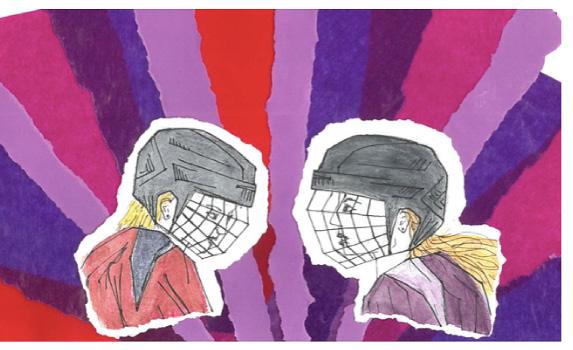
As one of the largest cities in the U.S., Chicago has a passionate fanbase that hosts teams across
all major leagues, which would make for a vibrant environment for a new hockey team. The city is already home to a plethora of youth programs, which could help build local talent pipelines. With elite facilities like the United Center and Wrigley Field, Chicago has the infrastructure to successfully host a PWHL team. Its central location also makes it an ideal hub for travel within the league with potential for friendly regional rivalries.
Vancouver would be another strong option as a host city due to its deep love for hockey and it being one of Canada’s most vibrant urban scenes. As home to the National Hockey League (NHL)’s Canucks and a thriving hockey community, Vancouver has a community of passionate fans who would embrace professional women’s hockey. The city’s picturesque setting and multicultural community would make it an appealing market for players, fans, and sponsors. Expanding to the West Coast also catches the eyes of potential donors for the PWHL, which could help build the league across all facets. Considering its reputation for hosting successful sports events in venues such as Rogers Arena, Vancouver has the means and community needed to host a franchise and grow the league’s presence on the West Coast.
Lastly, Detroit would be a qualified host city for a PWHL team, given its rich hockey culture and passionate fanbase. Known as “Hockeytown,” Detroit has a deep connection to the sport, with a long history of supporting the NHL’s Red Wings and a strong
culture of youth hockey. With a community that values the sport as a whole, Detroit fits the criteria of what is needed to support a PWHL team.
Chicago, Vancouver, Denver, and Detroit each offer unique opportunities to help expand the PWHL and elevate professional women’s hockey. Denver’s public display of enthusiasm for a team may prompt the PWHL to prioritize adding them to the league before others. While Chicago’s status as a major sports centre with a thriving hockey culture would attract a large and diverse fan base, the PWHL may prefer a team based on the West Coast to help expand the league’s reach, like Vancouver. As a Canadian hockey hub with a proven track record of supporting women’s hockey events, Vancouver would further solidify the League’s presence in Canada. Detroit, with its deep hockey roots and reputation, offers a perfect blend of tradition and enthusiasm for the sport, but it may not be able to compete with larger fan bases in its area, like Chicago. Looking at the current league, there are three American teams and three Canadian teams, so one could predict that the PWHL would choose to add one team from the US and one team from Canada to maintain a balance for future seasons. All of these cities provide a mix of geographic diversity, supportive fan bases, and resources to help the PWHL continue to grow and inspire future generations of players and would all be exceptional additions to the league.
Samathar Senso Staff Writer
Over four million Canadians contract food poisoning every year, making it a relatively common—although intensely unpleasant—ailment. The most commonly identified culprits are undercooked red meat, poultry products, and seafood. However, fresh produce is another source that often gets overlooked. As the general public increasingly recognizes fruits and vegetables as integral parts of a healthy diet, our overall consumption of fresh produce is rising, resulting in increased bacterial outbreaks in the produce supply chain.
In a recent paper, Pierre-Luc Longchamps, a PhD student at McGill’s Department of Food Sci- ence and Agricultural Chemistry, and his colleagues studied how bacterial contamination of fresh produce at each step of the supply chain, along with bacterial dormancy, allows bacteria to entrench itself into our produce.
Typically, bacteria that cause food poisoning, such as E. Coli, Salmonella, and Listeria, are not naturally present in fresh fruits and vegetables. Instead, contamination occurs through contact with wildlife before harvesting, through human handling, and from unsafe food storage conditions during processing. This can happen at various stages of production, from contaminated surface water runoff on agricultural land or manure from livestock coming in contact
with produce, to the final stages of production if produce is packed in a contaminated environment.
“A major source [of infection] is from a handler, so anyone who’s picking, cleaning, cutting, or processing the produce. If they themselves are sick, they can often spread it to the food,” Longchamps said in an interview with The Tribune
While people usually cook animal products such as meat and poultry before consumption, they often consume fresh produce raw, making contaminated produce more likely to impact us since cooking serves as an intermediate step to kill bacteria. Bacteria in fresh produce can also evade detection by entering a dormant phase—an adaptive state that makes them harder to measure.
Bacterial dormancy describes a period where bacteria stop growing and replicating in response to a stressor, allowing them to survive in harsh conditions. This is problematic, since current detection methods involve culturing bacteria on selective growth media.
“[Depending on their dormancy state], bacteria have an intact cell membrane and still [perform cellular] respiration, but if you put them on normal growth media, like a petri dish, they won’t grow [....] However, when ingested, we know that bacteria can revert back to their normal growing states and still cause infections,” Longchamps added.
Notably, bacteria culturing often uses
selective growth media, a controlled environment that only allows a specific bacterial strain to grow. This often prevents dormant bacteria from growing even in their own selective environment due to their dormant state, making detection even more difficult.
PCR testing, a method used to detect COVID-19 infections during the pandemic, is becoming a credible alternative to current culture testing for bacteria detection in fresh produce. This method could help detect the presence of bacteria even when they are dormant. However, it requires expensive equipment and highly trained laboratory professionals, and is prone to false positives—a test result which incorrectly indicates the presence of a condition.
In the past few decades, reports of bacterial outbreaks in fresh produce have been on the rise, which is likely because of increased testing and the prevalence of prepackaged mixed salads.
“For a long time, it was thought that vegetables were relatively safe, and people were more
concerned with meats, but as we became better at keeping our meat clean, there’s a lot more [testing] being done on vegetables [....] The rise in popularity of pre-bagged salads [also explains the rise in outbreaks] since you end up with vegetables being mixed together, and if a single vegetable is contaminated, then you end up contaminating everything else,” Longchamps explained.
While governments are implementing more preventive measures to prevent bacterial outbreaks and scientists are studying novel detection methods, consumers can also take a few measures: Actively checking produce recalls and thoroughly rinsing fruits and vegetables with running water.
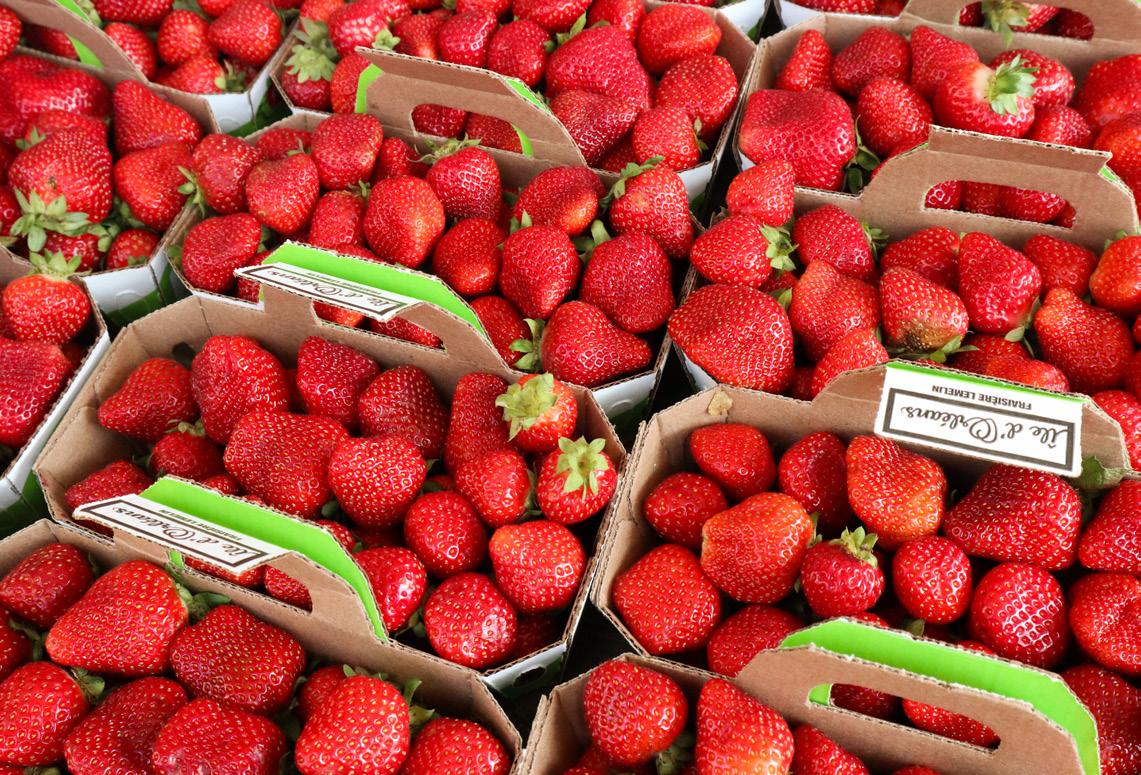
Lana Liquard Staff Writer
What does it mean to be alive? Could life exist elsewhere in the universe, and if so, how would we recognize it?
On Jan. 14, 2025, Dr. Michael L. Wong, Postdoctoral Fellow at Carnegie Science’s Earth & Planets Laboratory, addressed these mysteries during a seminar at the Trottier Space Institute (TSI) at McGill. Wong’s talk, titled Pondering Our Place in the Universe, showcased his interdisciplinary approach, blending planetary science, data science, and philosophy.
Wong began his presentation by framing the core questions of astrobiology: How does life emerge? And what makes a planet habitable? These questions, he argued, demand a multidimensional approach to better understand life’s inherent complexity.
Earth’s distinct atmosphere
One of the key focuses of Wong’s research is atmospheric chemistry. Earth’s atmospheric network is distinct from those of other planets. This could be because Earth’s atmosphere reflects a combination of its biosphere and technosphere—the part of the environment made up or modified by humans. Together, these two unique features form a technobiosphere.
“Earth’s atmospheric network is the most non-random network we’ve observed,” Wong noted.
This means that although everything in the universe is formed randomly, our atmosphere has the most non-random biochemistry that would be conducive to harbouring life.
This begs the question: Does life reorganize matter in a universal manner? And if so, it raises intriguing possibilities for identifying biosignatures—chemical traces of life—in the atmospheres of exoplanets.
How do we detect life?
The next part of Wong’s talk focused on methods to detect life beyond Earth. One method is the use of Pyrolysis Gas Chromatography-Mass Spectrometry (Pyrolysis GCMS), which uses heat to separate the chemical components of a sample to then analyze it. This approach, Wong explained, offers several advantages: Minimal sample preparation, versatility in extreme environments, and low energy requirements.
“If there is life on an alien world, it will not exhibit the exact same biochemistry as Earth,” Wong emphasized.
By training machine learning algorithms on a diverse range of biotic and abiotic samples, Wong’s team achieved an impressive 90 per cent accuracy rate in determining whether a sample contained evidence of life. However, challenges remain, particularly when identifying fossilized life or life concealed within mixtures of abiotic components.
Ethics of the Cosmos
Wong advocates for the development of
astrobioethics, an ethical framework to guide humanity’s exploration of outer space. With private companies, such as SpaceX, accelerating the path to space travel, Wong urged the audience to consider what constitutes moral value in the cosmos.
“We have an obligation to respect that which is morally valuable,” Wong explained.

“The big question is, what actually constitutes moral value in outer space?”
Should intrinsic value be assigned only to living entities, or do non-living structures with innate complexity deserve moral consideration? These questions are crucial to answer as humans prepare to venture into extraterrestrial environments.
Looking
From missions like NASA’s Europa Clipper and Dragonfly to the potential for samplereturn missions from Mars and Enceladus, Wong highlighted the exciting opportunities that lie ahead.
“These missions could revolutionize our
understanding of life in the universe,” he said.
Moving forward, Wong hopes to partner with space agencies to continue searching for signs of life in the cosmos. He also aims to bring more attention to the field of astrobioethics to fuel moral discussions on space exploration and interaction with the universe.
Wong’s seminar offered a thoughtprovoking mix of innovative science and deep philosophical reflection. By pushing the boundaries of planetary science and ethics, he is paving the way for humanity’s search for life beyond Earth.
“Astrobiology doesn’t just answer questions about life elsewhere,” Wong concluded. “It helps us better understand what it means to be alive here.”
When a
Michelle Yankovsky Contributor
Imagine taking what appears to be a harmless DNA ancestry test, expecting to uncover more information about your heritage, only to be met with the discovery that your assumed parent is not biologically related to you.
Direct-to-consumer DNA tests—such as those provided by 23AndMe and Ancestry—typically provide three pieces of information: The consumer’s ethnic heritage, an estimation of certain phenotypical characteristics, and a computation of the consumer’s biological relationships to other users within the database. With nearly 30 million people having taken these tests worldwide, it is estimated that nearly one million of them receive a “Not Parent Expected” (NPE) result, accounting for three per cent of all users.
In a recent publication in the journal BMC Psychiatry , Juliette Careau, a research assistant at the Douglas Research Centre and a recent graduate from McGill’s Master of Science in Mental Health program, investigated the mental health experiences of individuals who received NPE results from their DNA ancestry test.
“This sort of news out of the blue can be very shocking and stressful for participants,” Careau said in an interview with The Tribune . “To them, it was like losing half of themselves; it was like losing half

on surveys.
of their family tree.”
Careau also emphasized that this experience is heavily under-researched, leaving people who discover this news with a lack of resources and no established strategy to help navigate this distressing period of time.
“Our goal was to learn more about this topic and how it can affect people, with the hopes of potentially producing resources for this population, as [...] there is a lack of appropriate resources,” Careau said.
Careau collected data from 52 participants by conducting in-depth interviews, yielding qualitative data for the study. In 51 cases, participants learned that their assumed father was not their biologi -
cal father, with the other case being a participant who learned that neither assumed parent was biologically related to them.
The results suggested that there were five overlapping themes at play.
First, participants typically describe the experience as an extraordinary shock with a negative impact on their mental health. “I’m trying to figure out who the hell I am,” Participant 41 said in their interview with Careau.
Second, participants reported a severe disruption to their self-identity.
“Other studies I’ve read found similar results in terms of the feelings of grief experienced by self-identity loss,” Careau said.
Next, it was commonly reported that the NPE news often ruptured relations with the mother specifically. This impact was often more damaging in cases where the participant was revealed to have been conceived through an affair.
“Often in psychological studies, we see that we tend to blame our mother more than our father for different life events [in
general],” Careau noted.
The fourth theme was that participants often sought social support through friends, spouses, or online groups through platforms like Facebook.
“These groups were typically very useful for them, as it was very helpful to share their experiences and [be] validated by others,” Careau explained.
Lastly, a common theme across participants was seeking out mental health professionals. Interestingly, the study’s findings showed that not all participants found this support helpful.
“Some people did consult with mental health professionals [....] The experience with these professionals was a big mix,” Careau said. “[Participants said] they were not appropriately trained for the specificities of their situation.”
Careau stressed the importance of establishing future implications and guidelines for this population, with her research group working towards developing resources for clinicians to use in these specific situations.
While NPE results may appear to be a rare occurrence, they nevertheless affect one million people globally. Moving forward, examining the impacts that this type of news can have on genealogical test-takers through a more quantitative approach may help to establish better resources for those dealing with the aftermath of taking a ‘harmless’ DNA ancestry test.
Think you know how your friends feel? Think again Exploring the association between “empathic accuracy” and “cognitive empathy”
Sarah McDonald Staff Writer
Can you always accurately tell how your friends are feeling? What about the stranger across from you on the metro? Can you differentiate between someone smiling out of happiness, excitement, or contentment?
If you think “yes,” recent research may come as a surprise.
Alexandrija Zikic, a graduate psychology student working in McGill’s Child and Adolescent Social Competence Lab (CASC Lab), recently published a paper in Personality and Individual Differences . This paper explores the relationship between measured empathic accuracy—one’s ability to accurately interpret the thoughts and feelings of those around them—and self–reported levels of cognitive empathy, which is defined as the ability to recognize and understand someone else’s emotions.
“Both of these things should theoretically measure the same thing, [but] they don’t always— they’re not always associated with each other,” Zikic said in an interview with The Tribune
Zikic’s team investigated this discrepancy, attempting to understand the relationship between empathic accuracy and cognitive empathy. First, the team had participants complete a survey to self-report their levels of cognitive empathy.
They answered explicit questions like,
‘I can often understand how people are feeling even before they tell me,’ [and other] things like that,” Zikic explained.
Then, the researchers measured empathic accuracy using two different methods: Once through an interaction with a friend they brought to the lab, and a second time by watching six short films of adult strangers speaking about an emotional experience.
Surprisingly, the results of the cognitive empathy and empathic accuracy tests— which one might expect to align perfectly— had no association.
“My ability to read the emotions of one adult often has nothing to do with my ability to read another adult. It also has nothing to do with my ability to read my friend,” Zikic said.
These findings indicate that the ability to read others’ emotions depends not only on empathic ability but also on how much others are expressing themselves and how accurately these expressions reflect their feelings.
The study also questioned if and how levels of empathic accuracy change between speaking with a friend versus a stranger. One might expect higher levels of empathic accuracy when participants were speaking to friends rather than when watching a video of a stranger. However, this was not the case.
“[Participants] did better with the six adults every single time,” Zikic said.
This may be partly because the researchers presented the videos of the strangers in a
uniform, controlled environment, and the strangers were prompted to display their emotions prior to being filmed.
“[The strangers in the videos] have to do this whole visualization procedure beforehand to really get themselves in the zone to re-feel those emotions and communicate them,” Zikic described.
The interactions they had with friends were much more natural and spontaneous, providing a better representation of everyday life.
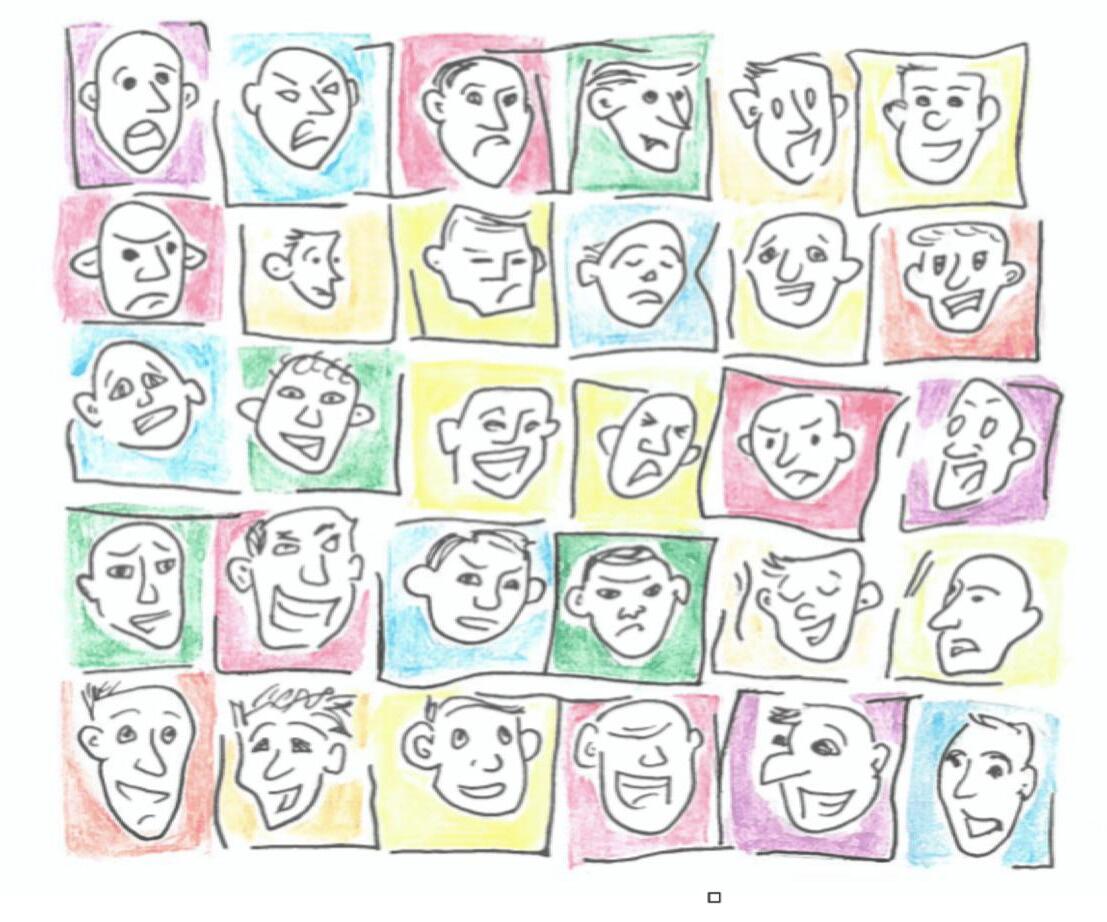
There are three different types of empathy: Cognitive empathy, affective empathy, and compassionate empathy. ( Lily Ashton / The Tribune)
“[When talking to a friend] you’re not just paying attention to how the person’s feeling. You have to think of responses in your head. You’re thinking, ‘Am I being supportive? What should I say next?’ There’s a lot more things going on that you have to think about,” Zikic explained.
The study’s findings also showed that gender significantly predicted empathic accuracy, with women being measured to have higher levels of empathic accuracy than men. However, the study found that men
report their levels of empathic accuracy more accurately than women, who tend to overestimate their ability. Combined, these findings highlight the social pressure women feel to be empathetic.
Zikic’s work shows that being able to accurately express yourself and communicate your feelings is critical to being understood. So, don’t assume you and your friends know how each other feel; talk about your emotions and clarify what has been lost in translation.
“We can’t necessarily assume people are reading our minds,” Zikic said.
Jamie Xie Staff Writer
Twas a dark and stormy night, when the screen flickered bright. Not a creature was stirring, not even a bite. The Christmas bells jingled, but something wasn’t right. Shadows were creeping, the moon hid from sight. Nosferatu emerged, a creature of night. We finally found out who was flickering the lights. As we gathered around for a tale of pure fright, it quickly became clear that fear had taken flight.
Seeing Nosferatu’s opening on Christmas Day was like receiving a funeral arrangement for Valentine’s Day—a flowery ode to the sacred and the beautifully profane. Like a guardian angel announcing its presence, Nosferatu reminds us: Do not be afraid of the dark! At the heart of the film lies the forbidden gothic romance of Ellen Hutter (Lily-Rose Depp) and Count Orlok, also known as “Nosferatu” (Bill Skarsgård). Driven by an ancient hunger, the two become entangled in a hunter-prey dynamic that blurs the boundary between obsession and temptation.
Fully embracing the inky space of historical horror, Robert Eggers delivers signature authenticity through meticulous period-accurate sets, costumes, and dialogue. It’s apparent that Eggers is no stranger to the dark, and with his acclaimed work on The VVitch and The Lighthouse, Nosferatu serves as a natural successor in his repertoire—perhaps his most impressive
work to date. Through its dramatic tricks of light and dark, the film pays tribute to gothic horror style, referencing the German Expressionism movement that defined the 1922 original. Just as vampires can only enter a home when invited, Nosferatu extends a chilling invitation to its audience to “succumb to the darkness” with a series of promotional coffin-shaped popcorn tins and rat plushies in its plague-themed marketing campaign.
Lily-Rose Depp delivers a standout performance as Ellen Hutter. She performs long-take convulsion scenes, prescription breakdowns, and the unique psyche of a woman who grieves the living. In a role where the stakes could not be higher, Depp conjures a desperate lover, convincing housewife, and sympathetic patient in the demanding role of Ellen.
A new addition to the world of Nosferatu, Willem Dafoe plays Professor Albin Erbehart von Franz—an occult scientist introduced in the 2024 rendition. The character seemingly takes inspiration from Dr. Caligari of the Cabinet of Dr. Caligari, a hallmark of German Expressionism often double-featured with Nosferatu in screenings. Through this character, the film suggests that increasing reliance on science has made man less tolerant of mysteries beyond our understanding. He declares: “We are not so enlightened as we are blinded by the gaseous light of science. I have wrestled with the Devil as Jacob has wrestled the angel.” von Franz reminds us that life changes amidst technological advancement; though cities may grow, graveyards will always remain.
Nosferatu subverts the conventions set by its contemporaries, existing as a countercultural response to the pop culture interpretation of the vampire myth. While drawing inspiration from Bram Stoker’s Dracula, Nosferatu diverges radically, embracing an unsettling intimacy with repulsion. While vampires traditionally intertwine repression and sexuality, Nosferatu presents himself as a hideous manifestation of unbound evil and ailment, even when presenting themes of temptation. His name derives from the Greek “nosophoros,” meaning “plague carrier,” reinforcing the idea of vampirism as an otherworldly disease. While Dracula manipulates with charisma and seduction, Nosferatu hypnotizes with pure psychological force. His love is an affliction that corrupts contagiously and is characterized by a brutality that makes Dracula pale in comparison.
We skeptical lovers often convince ourselves that evil things have an inherent allure or
The Tribune’s top picks for films, novels, and TV shows
The Eternal Memory (dir. Maite Alberdi)
Shani Laskin, Managing Editor
From Chilean director-producer Maite Alberdi, The Eternal Memory follows life partners Paulina Urrutia and Augusto Góngora as they navigate the latter’s Alzheimer’s diagnosis. The film intertwines the couple’s day-to-day routines with home videos and archived footage of Góngora’s career as a broadcast journalist during the repressive Pinochet regime in Chile.
In the documentary, Urrutia—an actress, union leader, and politician—reckons with caring for her partner as his mobility and cognitive function increasingly deteriorate while acknowledging the reality that he is slowly forgetting who she is. Through this film, these two beloved figures of Chilean public life literally open the door to their most intimate moments, baring themselves to the world. Urrutia’s commitment to her husband and to ensuring that his legacy lives on is an act of tremendous selflessness. Clips of Urrutia leading Góngora on walks juxtaposed with moments of desperation when he fears his beloved books will be taken away from him emphasize the joy, peacefulness, and immense heartache in the act of loving through the loss of memory.
In addition to the remarkable love between the Urrutia and Góngora, what sets the documentary apart is the throughline of memory not just as a personal endeavour but as a political tool. Góngora’s career was defined by a commitment to truth-telling despite the threat of imprisonment, torture,
and even death. Through his work and activism, Góngora stressed the importance of documentary to fuel action and reconstruction. In a way, The Eternal Memory can be viewed as his final attempt to do exactly that.
The Vegetarian (Han Kang)
Kellie Elrick, Arts & Entertainment Editor
Content warning: Eating disorders, self-harm, sexual violence.
When the novel begins, Yeong-hye is having violent dreams—murder, barn floors soaked with blood, frothing mouths, cuts, faces. She stops eating meat, and eventually stops eating altogether. She gives up sex. She dreams of transforming into a plant.
The Vegetarian is written in three parts, each with one voice: Yeong-hye’s husband, her brother-in-law, and her sister. The novel begins in the first person and eventually moves into the third, becoming estranged from itself as Yeong-hye becomes estranged from her own body. She desires to escape the body in order to rid herself of the thing that eats, hurts, the thing men look at, and violate.
Yeong-hye stands on her hands, imagining them as roots in the earth, wills flowers to bloom between her legs, bares her body to the sun, wanting to leave the woman behind and become the tree. The story is a much older one: In an ancient myth, Apollo, god of the Sun, music, poetry, and—most relevant to Kang’s story—healing and illness, falls in love with the nymph Daphne.
She tries to flee, but Apollo chases after her. Daphne, terrified, cries out to her father, a river god, who transforms her into a laurel tree.
But in Kang’s story, there’s no god to save Yeong-hye.
Swan Song (dir. Chelsea McMullan)
Charlotte Hayes, Arts & Entertainment Editor
“Ballet is punk rock as fuck,” says newly promoted corps de ballet member Shaelynn Estrada in the closing moments of Swan Song —and after watching Chelsea McMullan’s docu-series, it’s easy to see why. The series offers an intimate look at the National Ballet of Canada as they take on the ambitious task of mounting an all-new version of the beloved Swan Lake, complete with fresh choreography by their long-time artistic director, Karen Kain.
hidden beauty. But Nosferatu rejects this notion. Unapologetically grotesque, he taps into modern anxieties beyond reason to engage with the primal disgust within us and challenge our beliefs about morality. Orlok has very little to redeem himself with—he’s not complex, not an antihero. He is neither sympathetic nor vengeful—he is unknowable at best.
Remaining remarkably faithful to the 1922 original, this adaptation takes a stab at the silent horror classic, bringing it to life and delivering a holiday gift like no other—proving love, in its darkest form, never truly dies.

Over its four-episode run, the series follows Estrada alongside fellow cast members Jurgita Dronina and Siphesihle November as each navigates pivotal “breakthrough” moments in their careers during rehearsals. Swan Song brilliantly showcases the extraordinary mental fortitude demanded of professional ballet dancers, matching their physical endurance and artistic talent. From grappling with mental health challenges to the struggles of immigration and adjusting
to life in a new country, the series thoughtfully explores how ballet intersects—both positively and negatively—with the dancers’ personal milestones.
From casting to opening night, Swan Song delivers a comprehensive and unfiltered portrayal of what it truly means to give everything to your art. Blending the intrigue of a gossip-fuelled reality show with the stakes of a high-stakes sporting event, it immerses the audience in the joy and drama that drive one of the world’s most celebrated ballet companies.
Mia Helfrich Design Editor
If offered bread or a lottery ticket, which would you choose? Now imagine this question is posed only to students who are hundreds of thousands of dollars in debt. Which would they choose?
Released on Dec. 26, Squid Game Season 2 follows Seong Gi-hun (Lee JungJae) as he attempts to dismantle the Squid Game, a competition in which players must compete in childhood games for a prize of 35.6 billion ₩ (over $45 million CAD). Winners take home the money while losers die, and each player’s death increases the prize money for the remaining players. Contestants are cherry-picked for having hefty debts; most are motivated to play to escape a life of poverty, pay off medical expenses, or recover from an unlucky gamble. In his efforts to undermine the games, Seong becomes trapped in them instead. Losing contact with his militant team on the outside, he must confront the game’s organizer, the Front Man (Lee Byung-hun), on his own.
The first season premiered to unprecedented acclaim, and so far, Season 2 has been nominated for a Golden Globe and reached 152.5 million views on Netflix. Along with near-universal praise, the success of the first Squid Game led to a reality television spin-off and the second earned
a Google Doodle. The cinematography is breathtaking; one could get lost analyzing the lighting, colour, and contrast used in a single frame. Lee’s performance of Seong is particularly captivating as he embraces his character’s duality: Vengeful and strategic, yet frustrated and desperate. In Season 1, Seong is motivated by self-preservation, a few friends, and fortune; in Season 2, Lee expertly captures the transition to a character who is now fighting for all of the players’ survival.
This season’s antagonist is no longer fellow competitors, but the Squid Game itself and those in charge of the operation. It mimics the plots of films like the Matrix and Hunger Games: Catching Fire , where in the midst of violent conflict, both the audience and underdog characters have to “remember who the real enemy is.” Squid Game Season 2 excels in highlighting the humanity of individual players, ensuring the audience never forgets that the players are not the criminals—the games are the true perpetrators. Squid Game Season 2’s antagonist inversion not only creates plenty of action-packed and gory scenes, but it also reveals an obvious commentary about the exploitation of desperation among impoverished and indebted people in society. Characters that would have been received as villains in the first season, like the pinksuited soldiers hired to oversee and kill players, are made tragic and even sympathetic as their despair is equally as preyed
upon as the heroes.
However, while side character spotlights and side plots allowed the audience to focus on the players’ humanity rather than just that of the main characters, the expanding side characters failed to create a clear fan favourite. Viewers can empathize with every side character subject to the cruelty of the game, but each side character doesn’t have enough screen time to make their deaths nearly as emotionally devastating as in the first season.
A striking feature of this season is the increased representation of marginalized people within Korean society, featuring side characters such as a North Korean defector, individuals experiencing drug addiction, and a transgender woman, Cho Hyun-ju (Park Sung-hoon). Cho entered the games to acquire money for genderaffirming care, and is unfailingly heroic and caring. Though Cho represents a big step for the representation of 2SLGBTQIA+ characters in Korean media, the character would have been more accurately portrayed by a transgender actress.
Squid Game Season 2 is a masterclass in suspenseful pacing, creative cinematography, and mesmerizing performance, prompting the audience to empathize with those whom society leaves behind.
Squid Game Season 2 is now available on Netflix.

Beatrice Moen Contributor
Rating:

Released on Jan. 5th, Bad Bunny’s sixth studio album, DeBÍ TiRAR MáS FOToS (“I Should Have Taken More Photos”), has been celebrated as an “unabashed,” “determined,” “resonant,” and “triumphant” tribute to Puerto Rico. Beyond critical acclaim and chart-topping success—it currently holds the top position on Spotify’s Top Albums Chart—the album is Bad Bunny’s vibrant and impactful testament to loving his home, capturing the spirit of Puerto Rico in every track.
The album opens with “NUEVAYoL” (the Puerto Rican pronunciation of “New York”), a lively track beginning with a sample of “Un verano en Nueva York,” the 1975 classic by El Gran Combo de Puerto Rico, before layering on an infectious Dembow beat. This fusion of sounds is a defining feature of the album, where traditional Puerto Rican genres like salsa, plena, and jíbaro music are seamlessly interwoven with contemporary reggaeton, Dembow, and hip-hop beats. This artistic ambition and innovation has sparked intergenerational connections, with many TikTok users posting videos of their parents and grandparents reacting to the album, pleasantly surprised that younger artists and audiences are enjoying these sounds. The album also exclusively features Puerto Rican collaborators, including RaiNao, Chuwi, Dei V, Omar Courtz, Los Pleneros de la Cresta, and
students from the Escuela Libre de Música Ernesto Ramos Antonini in San Juan, the territory’s capital.
Lyrically, DeBÍ TiRAR MáS FOToS reflects Bad Bunny’s immense pride in Puerto Rico while shedding light on the challenges the region faces. As residents of an unincorporated U.S. territory, Puerto Ricans do not benefit from the same rights as other American citizens. Since “comedian” Tony Hinchcliffe referred to Puerto Rico as a “floating island of garbage” during a Donald Trump rally in October 2024, Bad Bunny’s pride in his island and support for its independence has only strengthened. In “LO QUE LE PASÓ A HAWAii” (“What Happened to Hawaii”), he criticizes the destructive effects of American imperialism on nature, culture, and communities in both Hawaii and Puerto Rico. Despite these challenges, Bad Bunny celebrates his Puerto Rican identity with gratitude and pride, declaring in “LA MuDANZA”: “De aquí nadie me saca, de aquí yo no me muevo” (“No one will take me from here, I’m not moving”).
The visual elements accompanying DeBÍ TiRAR MáS FOToS further reinforce its cultural, historical, and political depth. The album cover, which may appear simple at first glance, has evoked profound nostalgia among Latin American and diasporic communities, as seen in yet another viral TikTok trend where users showcase pictures of family or community gatherings centred around these white plastic chairs. The album’s Spotify visuals further extend this theme, featuring animated videos of the sapo concho, a toad native to Puerto Rico that is now endangered. These
symbols serve as poignant reminders of the need to protect and cherish the elements that make Puerto Rico so special. Additionally, in the lead-up to the album’s release, Bad Bunny debuted a short film starring legendary Puerto Rican filmmaker Jacobo Morales. The narrative follows Morales as an elderly man reflecting on life in his native country, with the central scene taking place in what was once a local cafe, now replaced by an American chain restaurant. There, the man encounters a cashier who speaks only English and sells “cheeseless quesitos” for $30. When he learns that the establishment doesn’t accept cash, a fellow Puerto Rican steps in to pay for him, before proudly declaring: “¡Seguimos aquí!” (“We’re still here!”). This striking short film serves as a powerful commentary on the realities of gentrification in Puerto Rico, whilst simultaneously celebrating the resilience and solidarity of its people.
DeBÍ TiRAR MáS FOToS fuses music,
culture, history, and politics to serve as a touching and lively tribute to all that Bad Bunny’s home island embodies. To produce such a proudly Puerto Rican album at the height of his career is perhaps the artist’s most ambitious decision yet.







